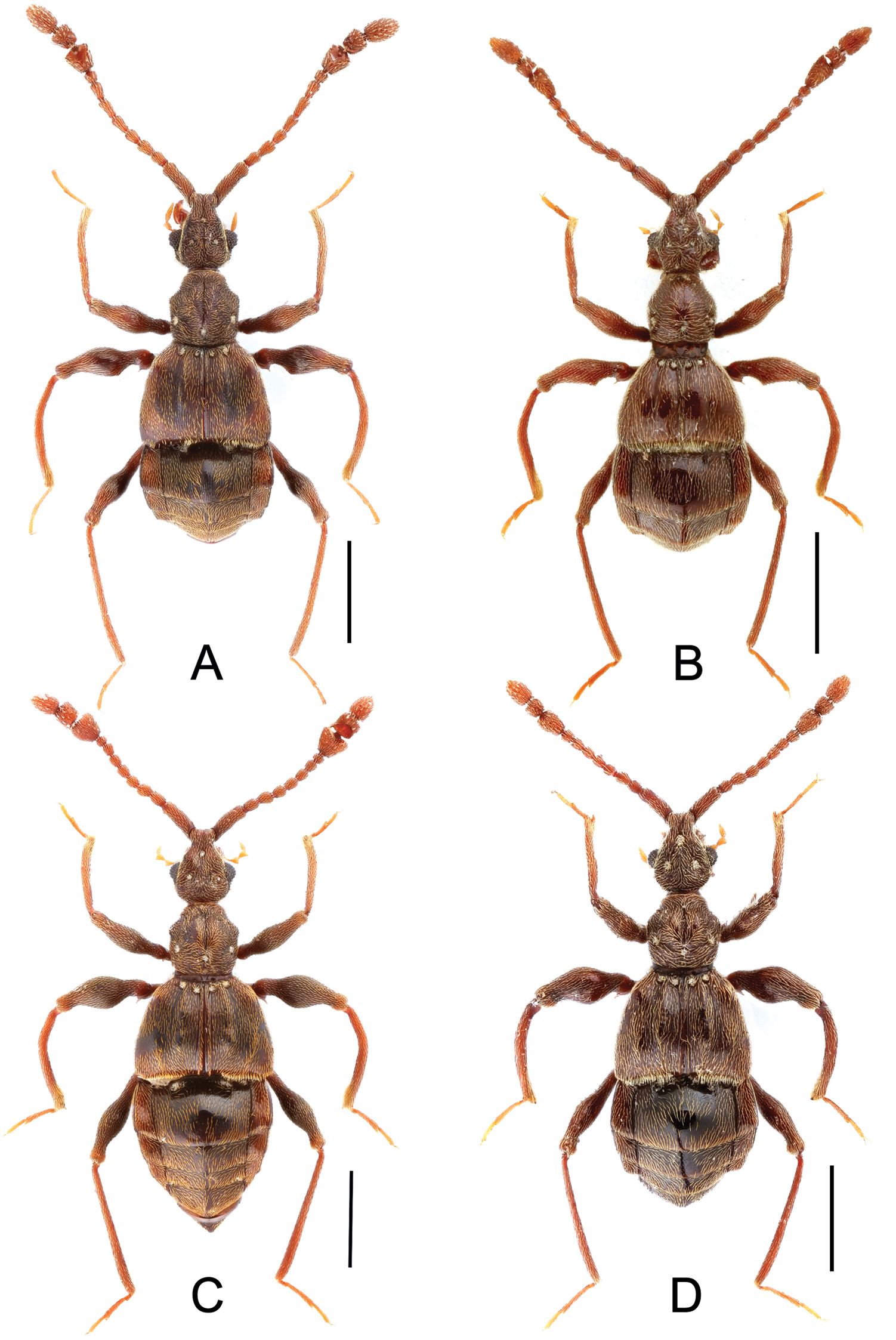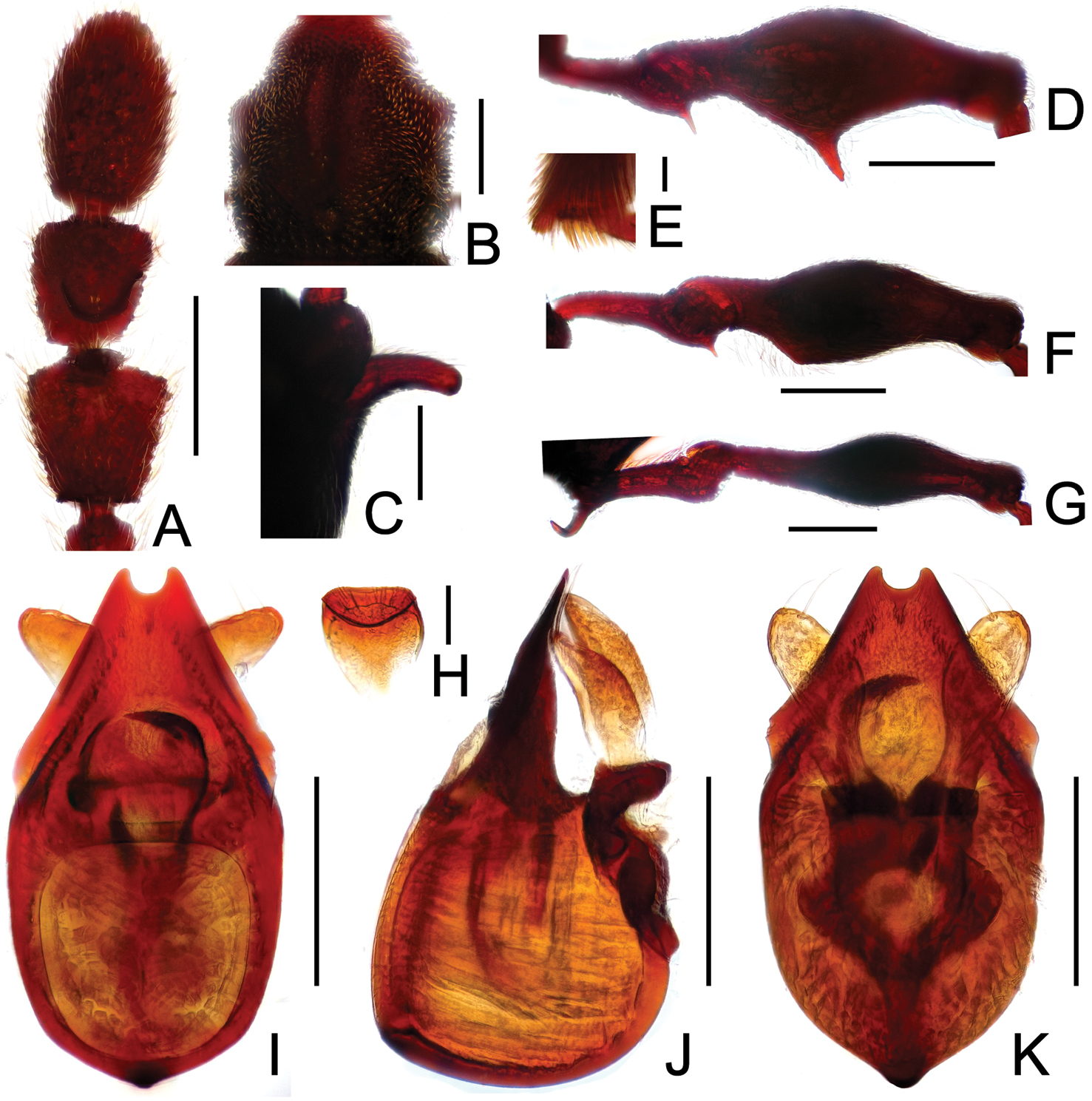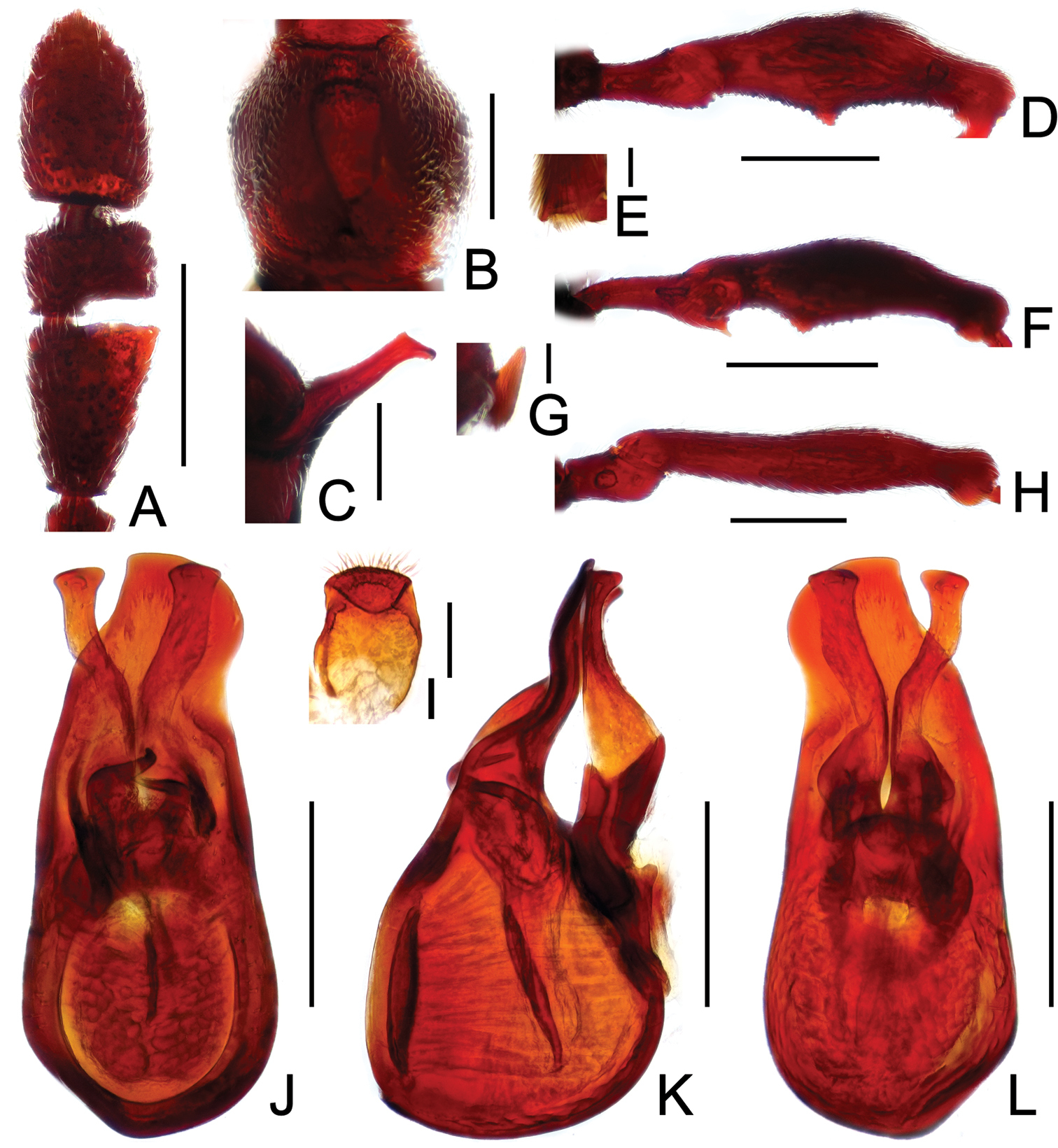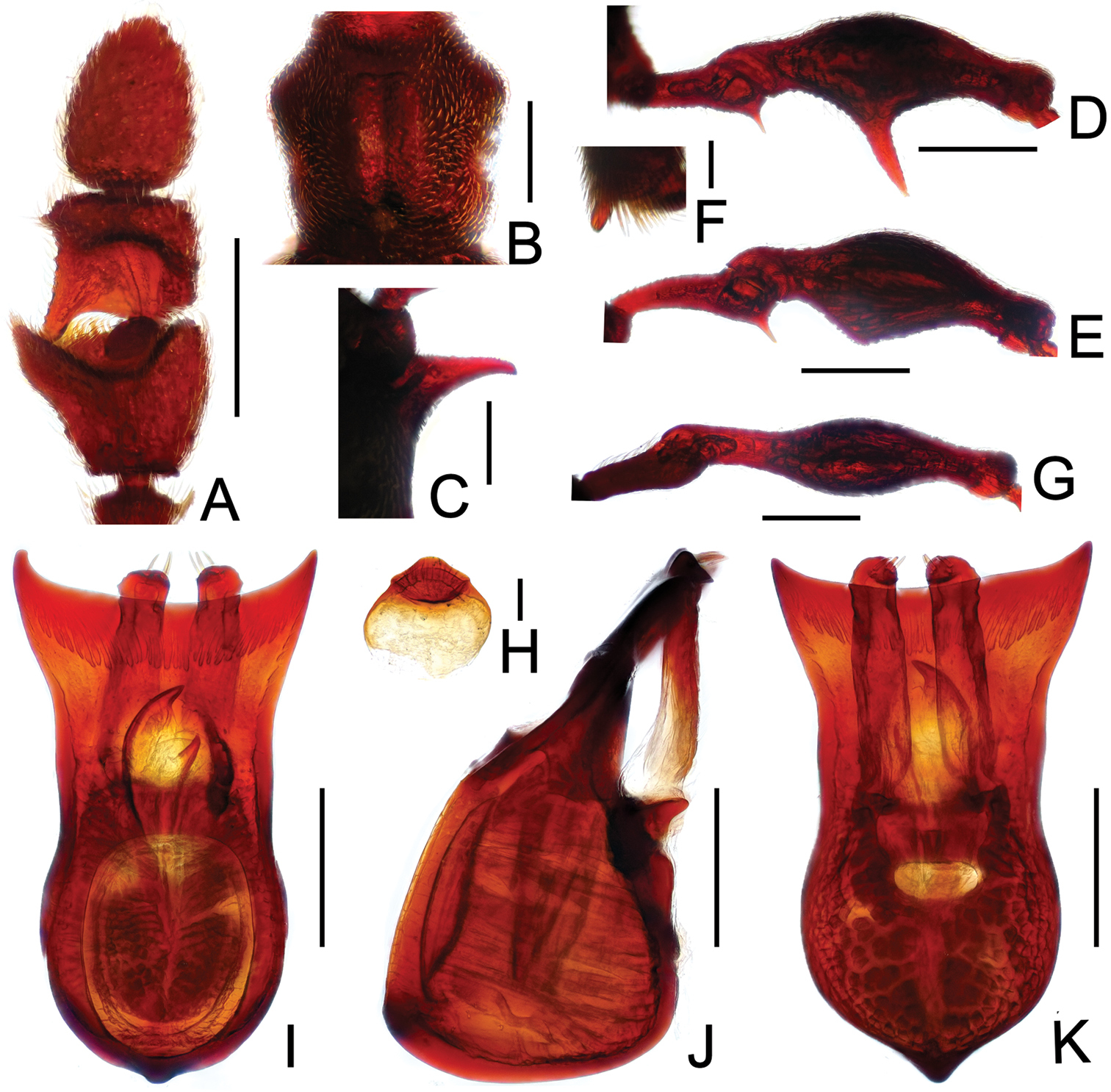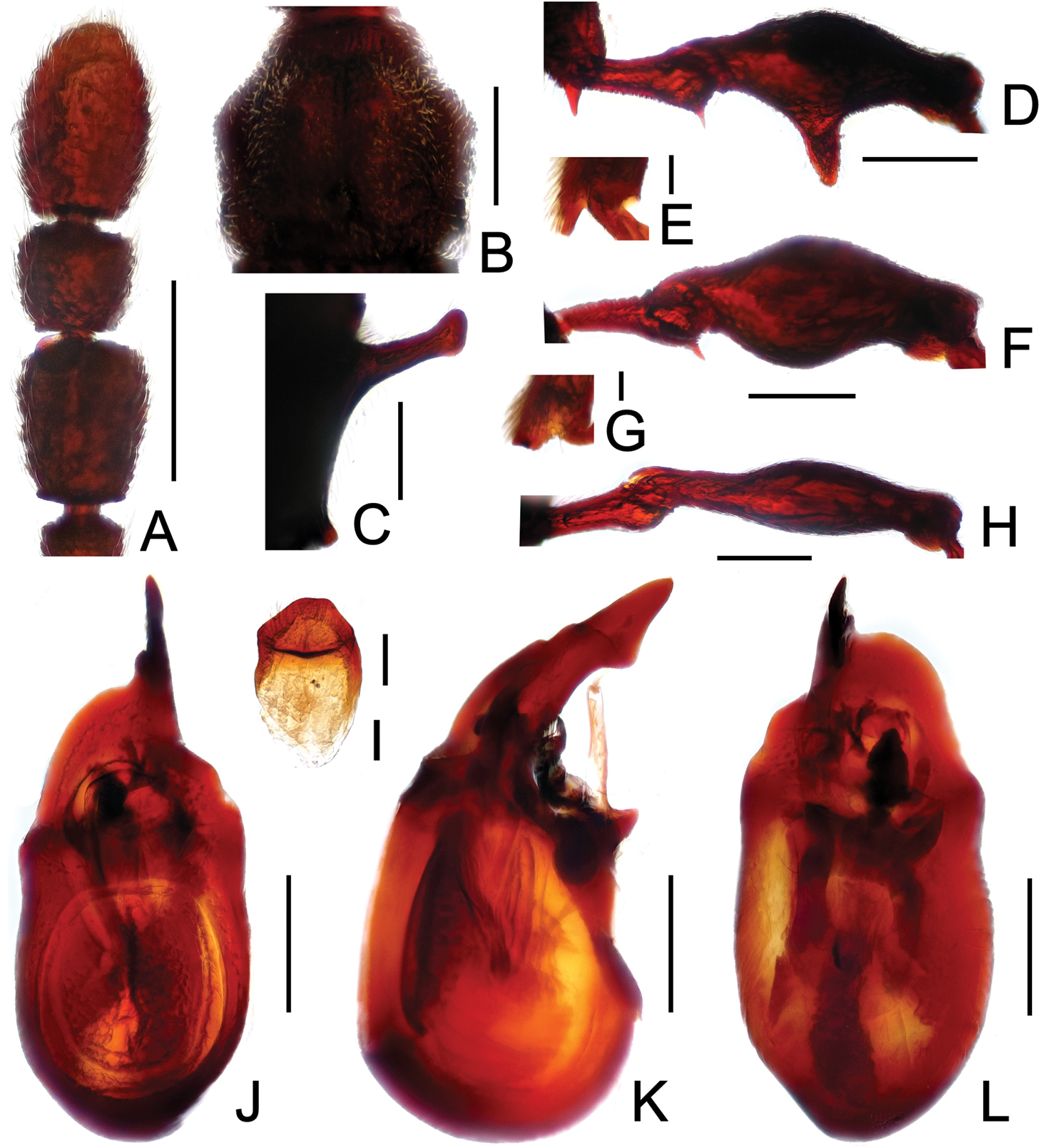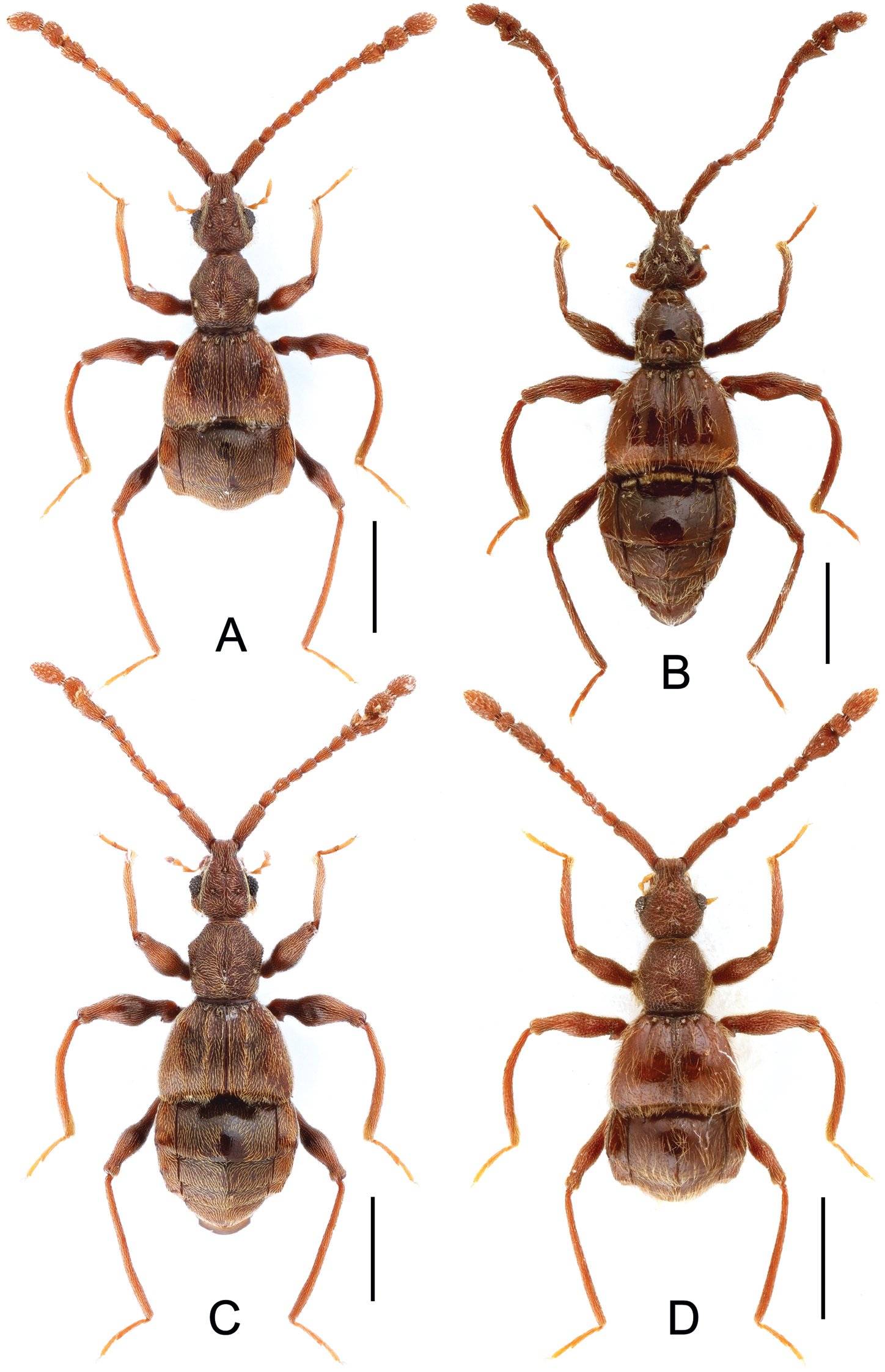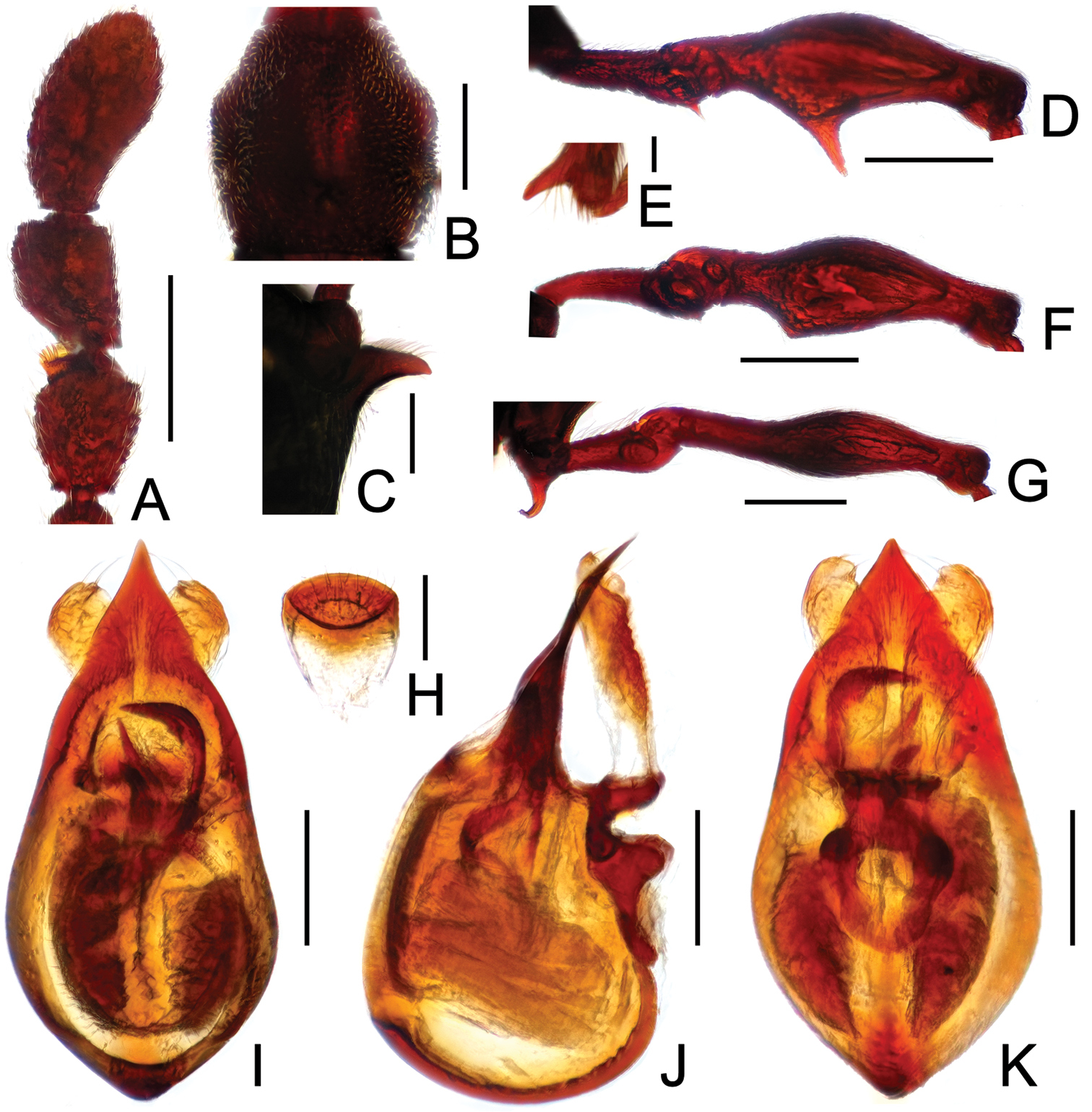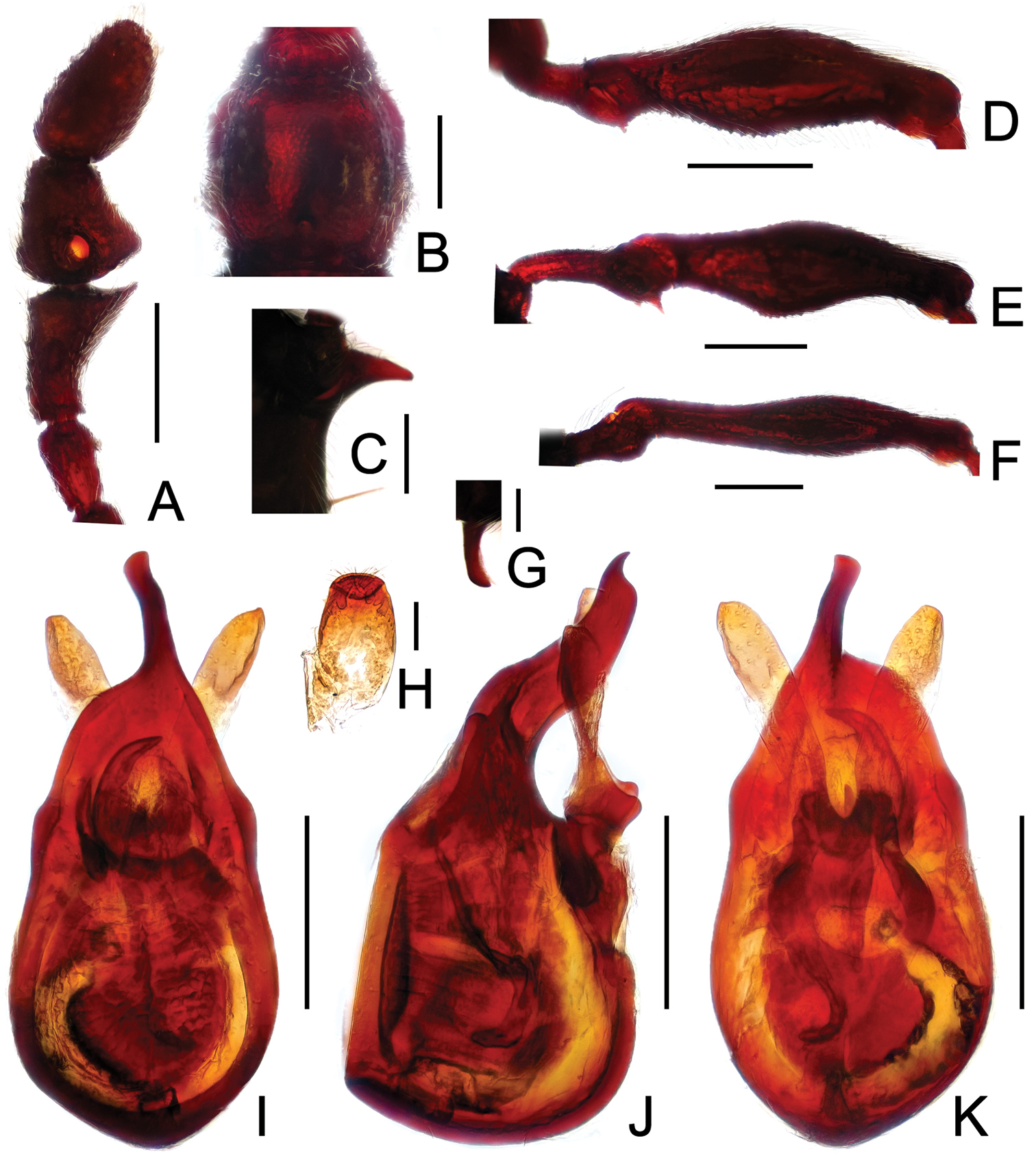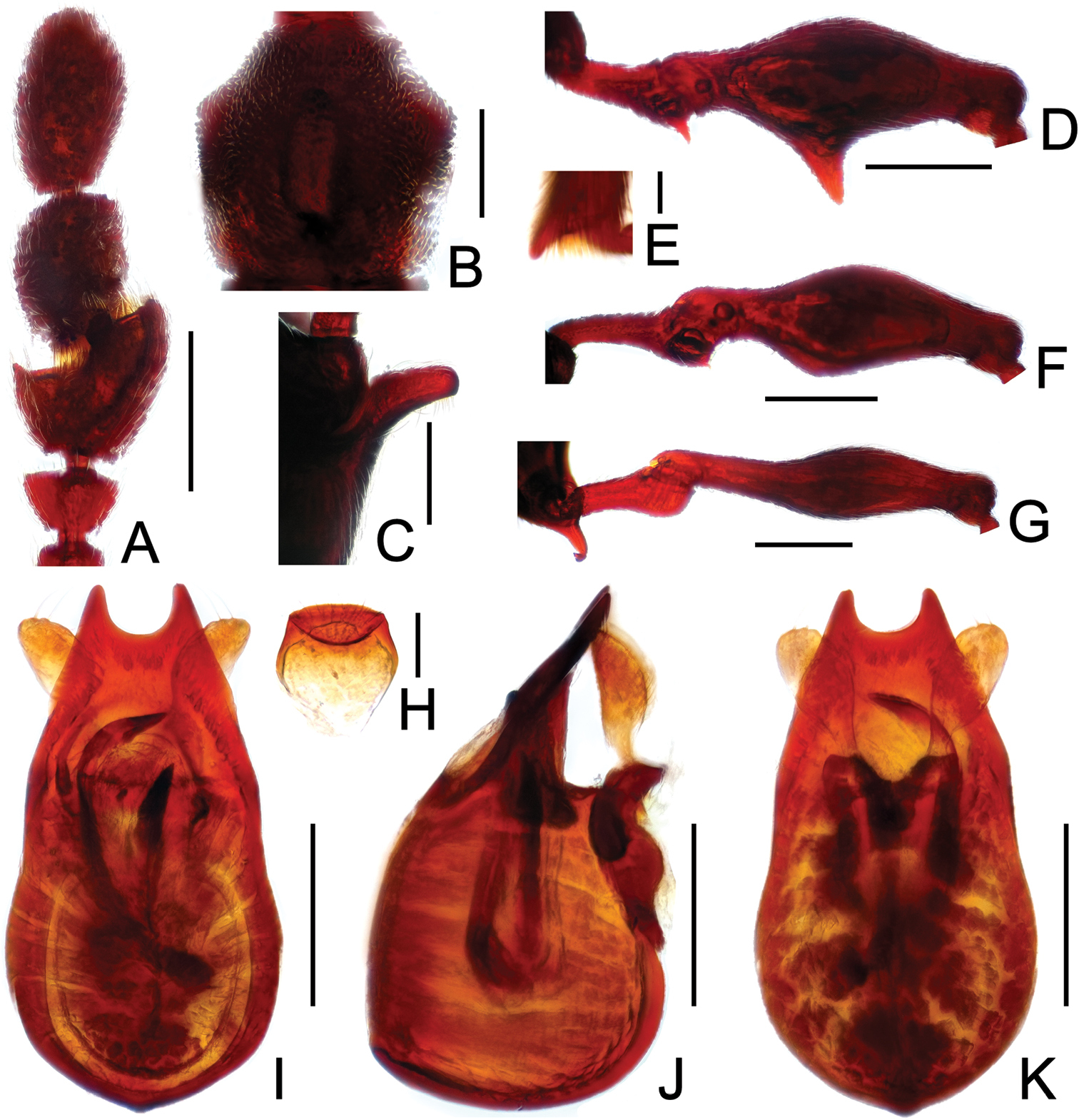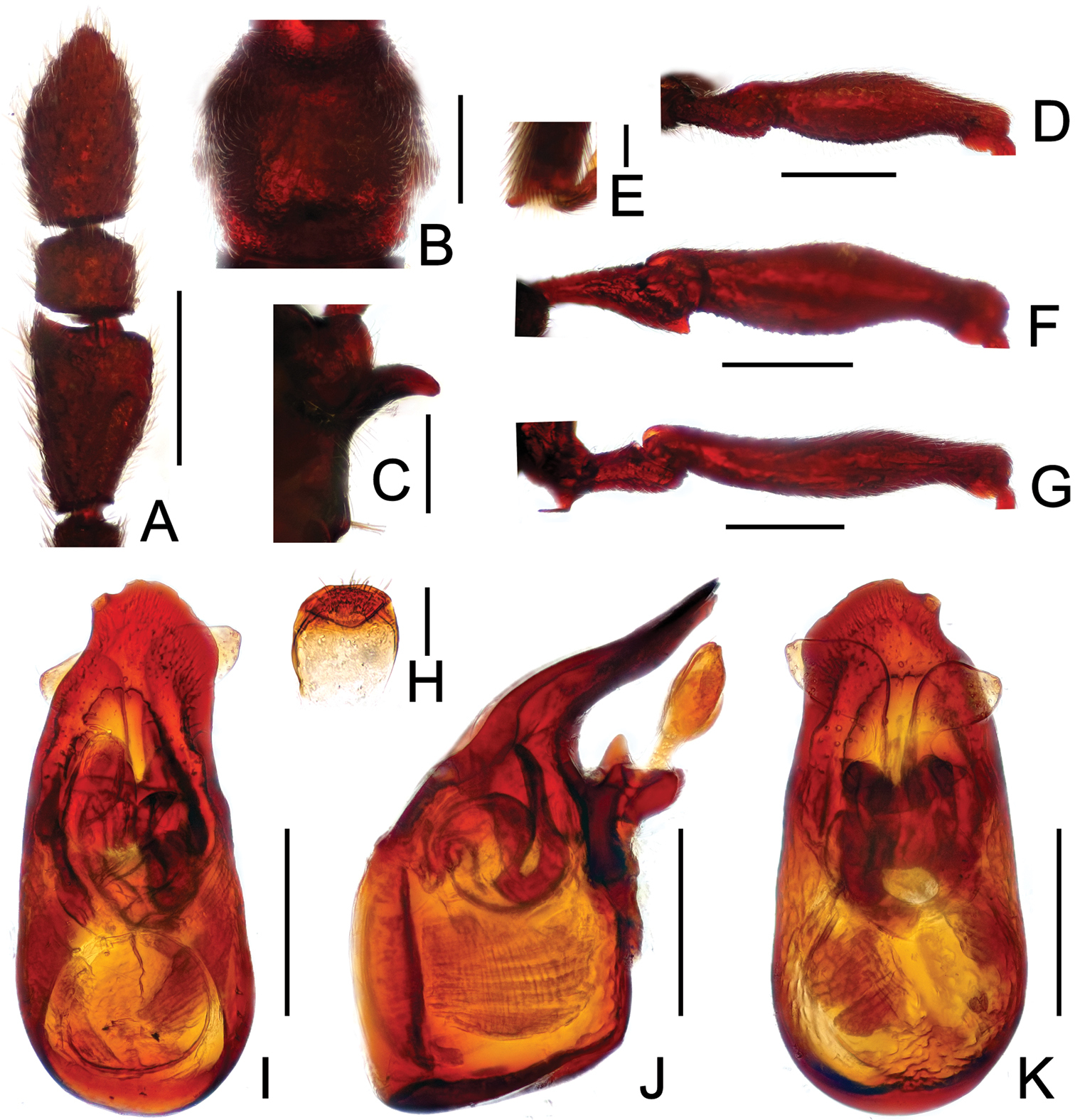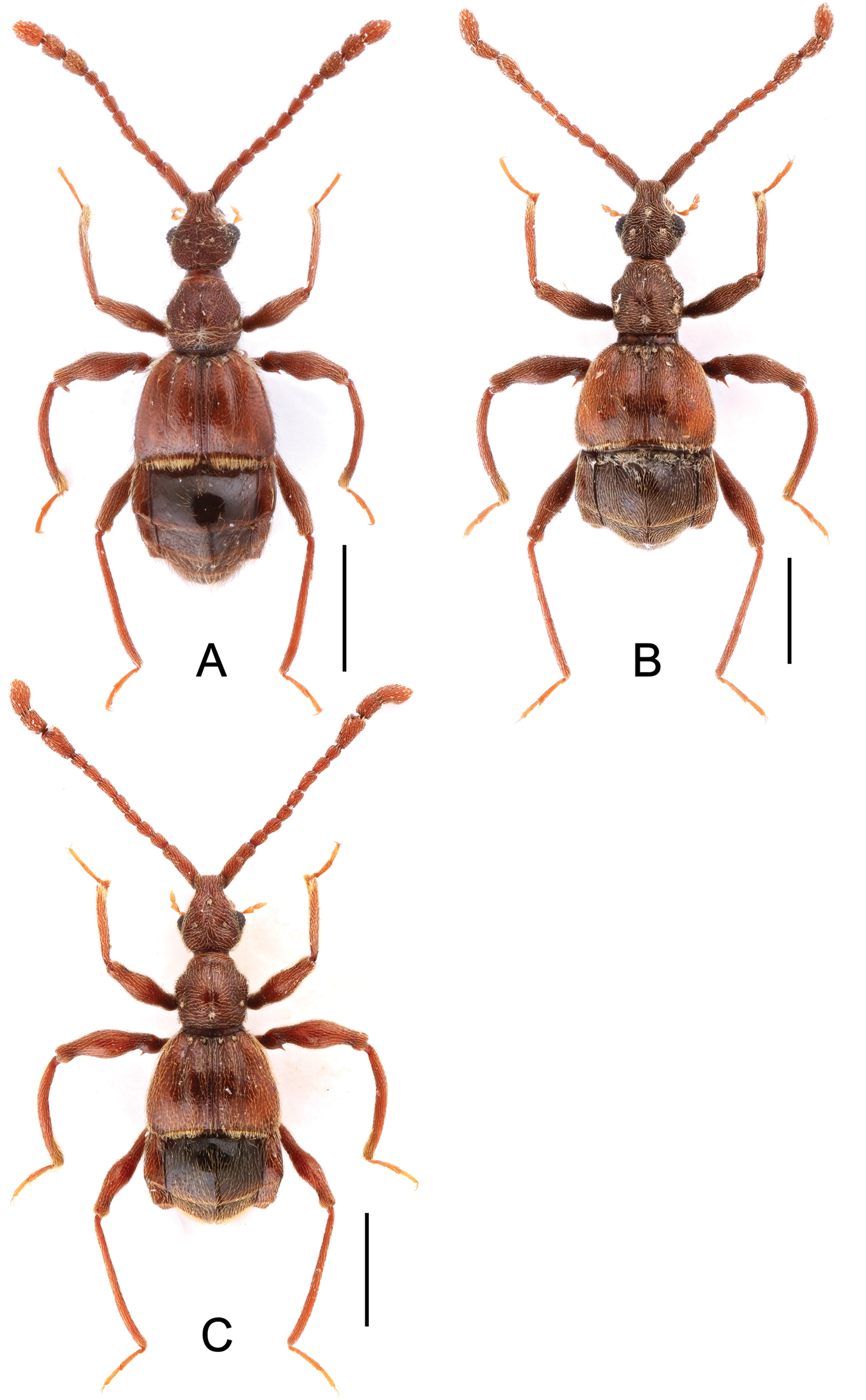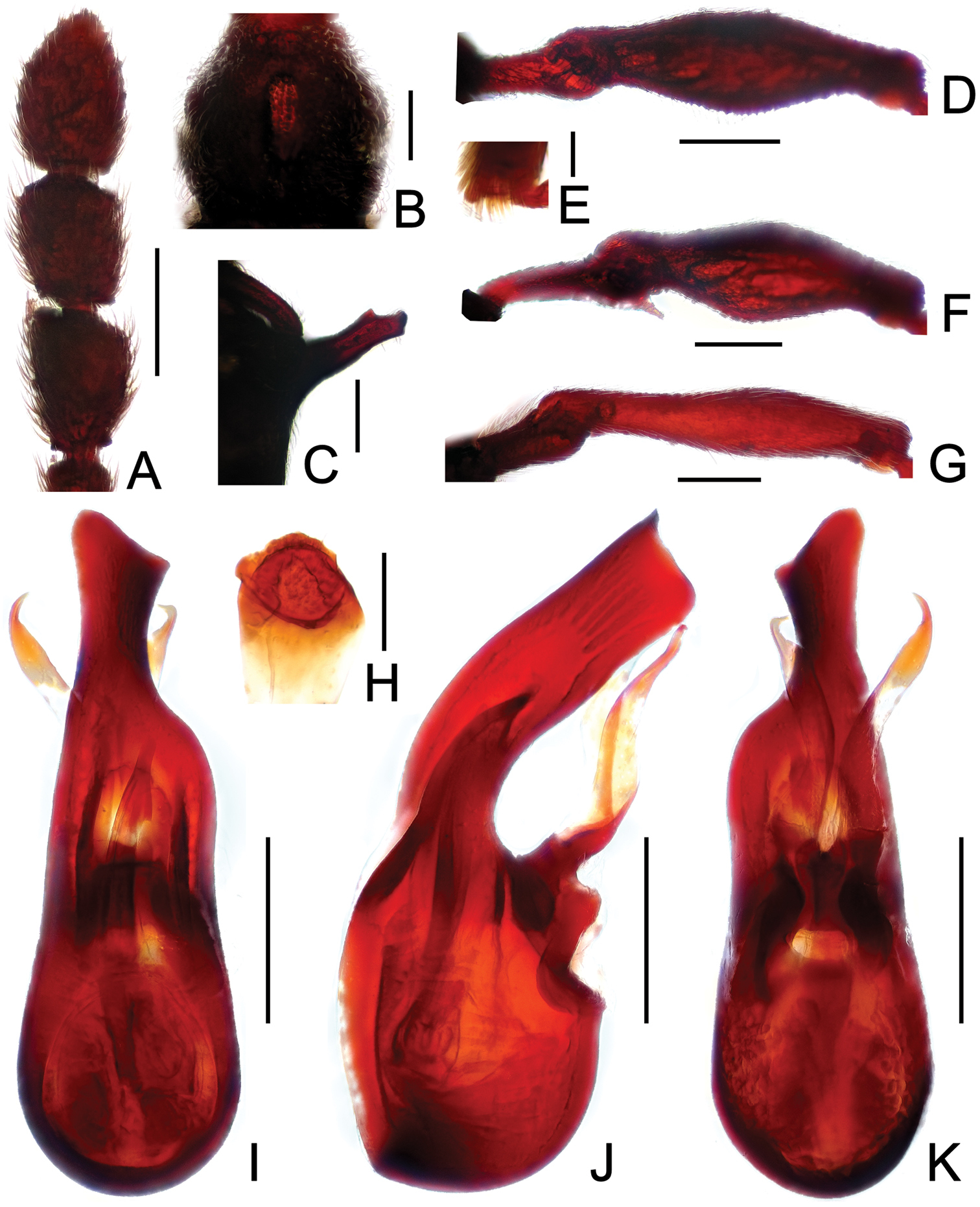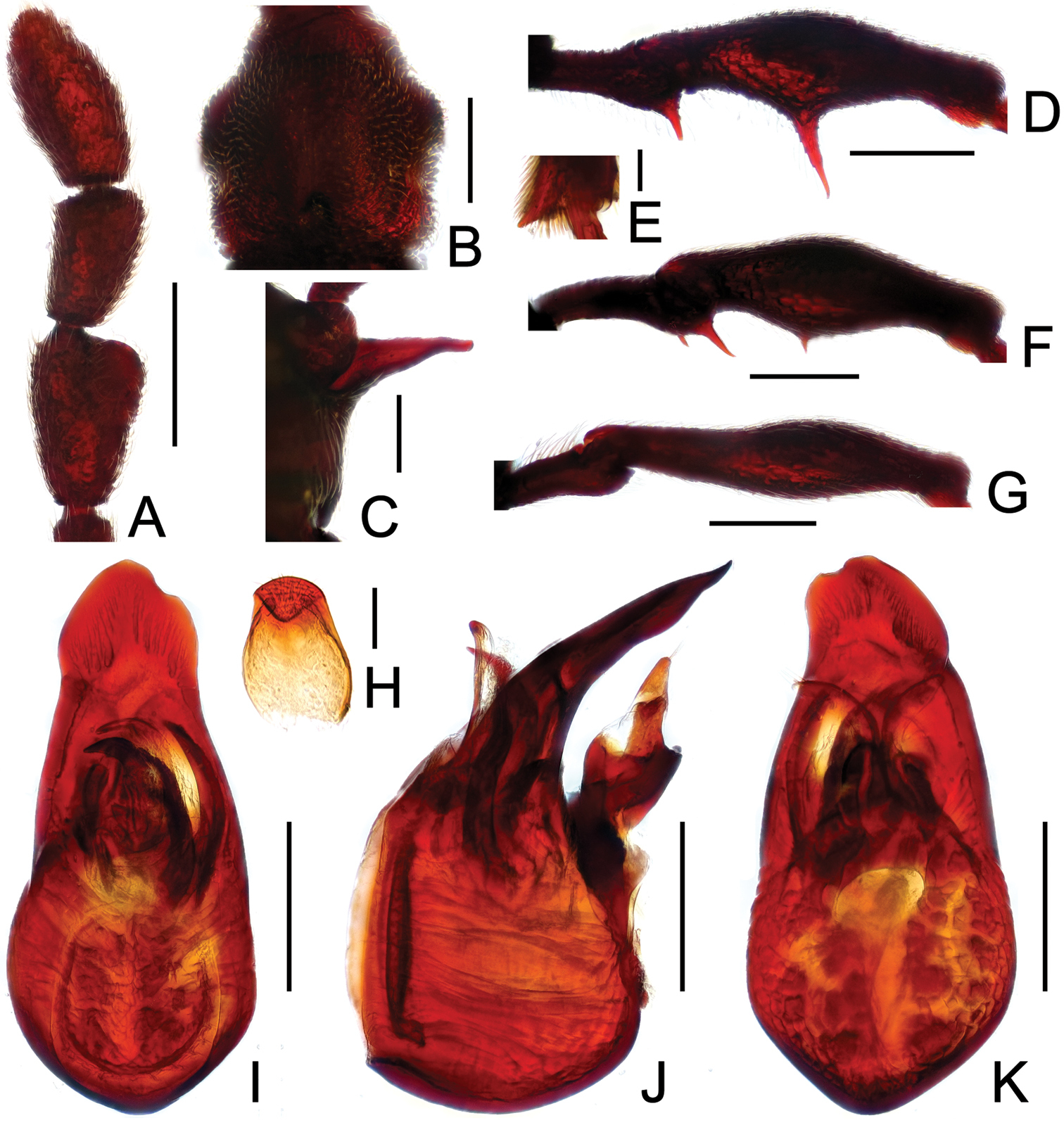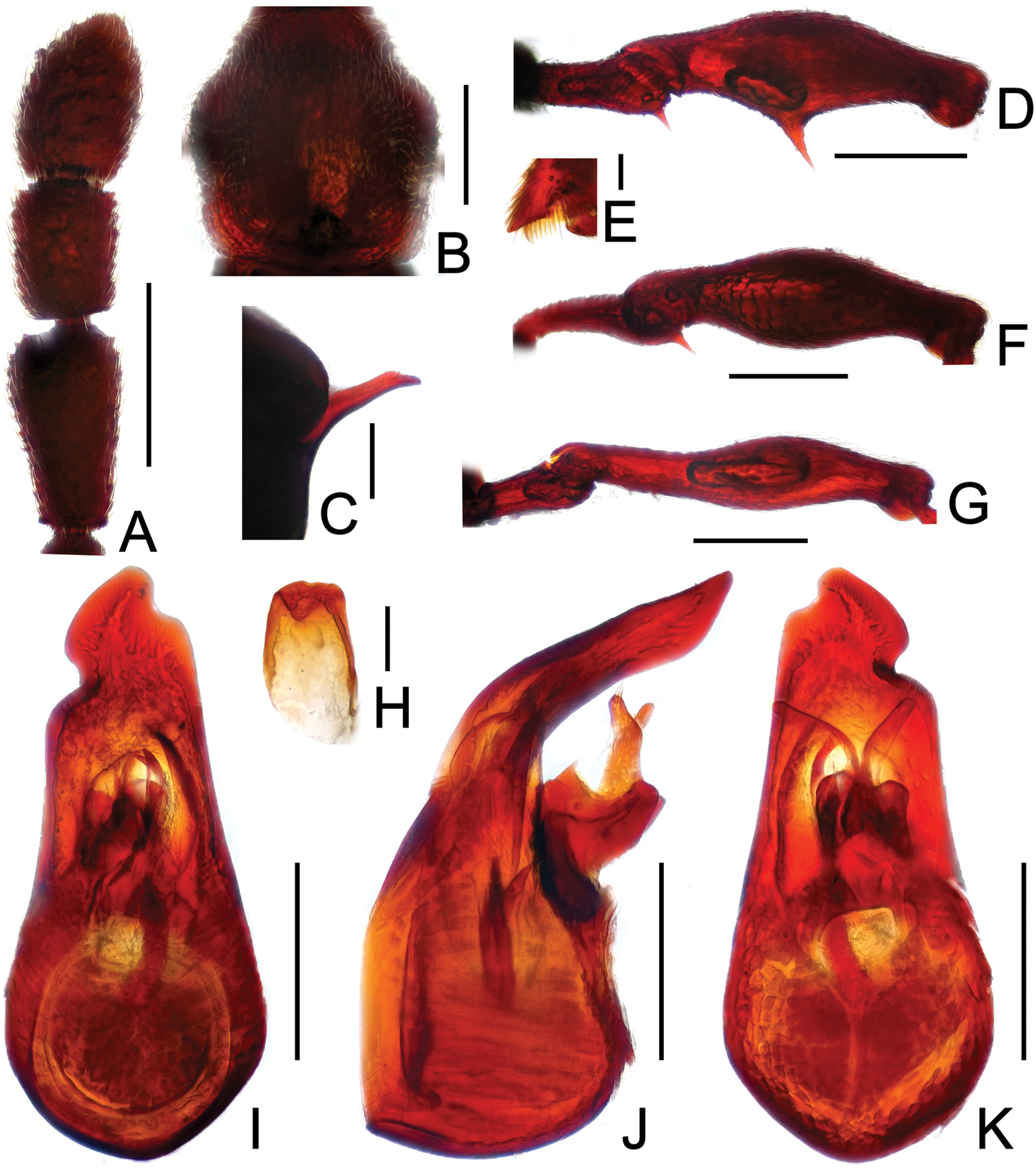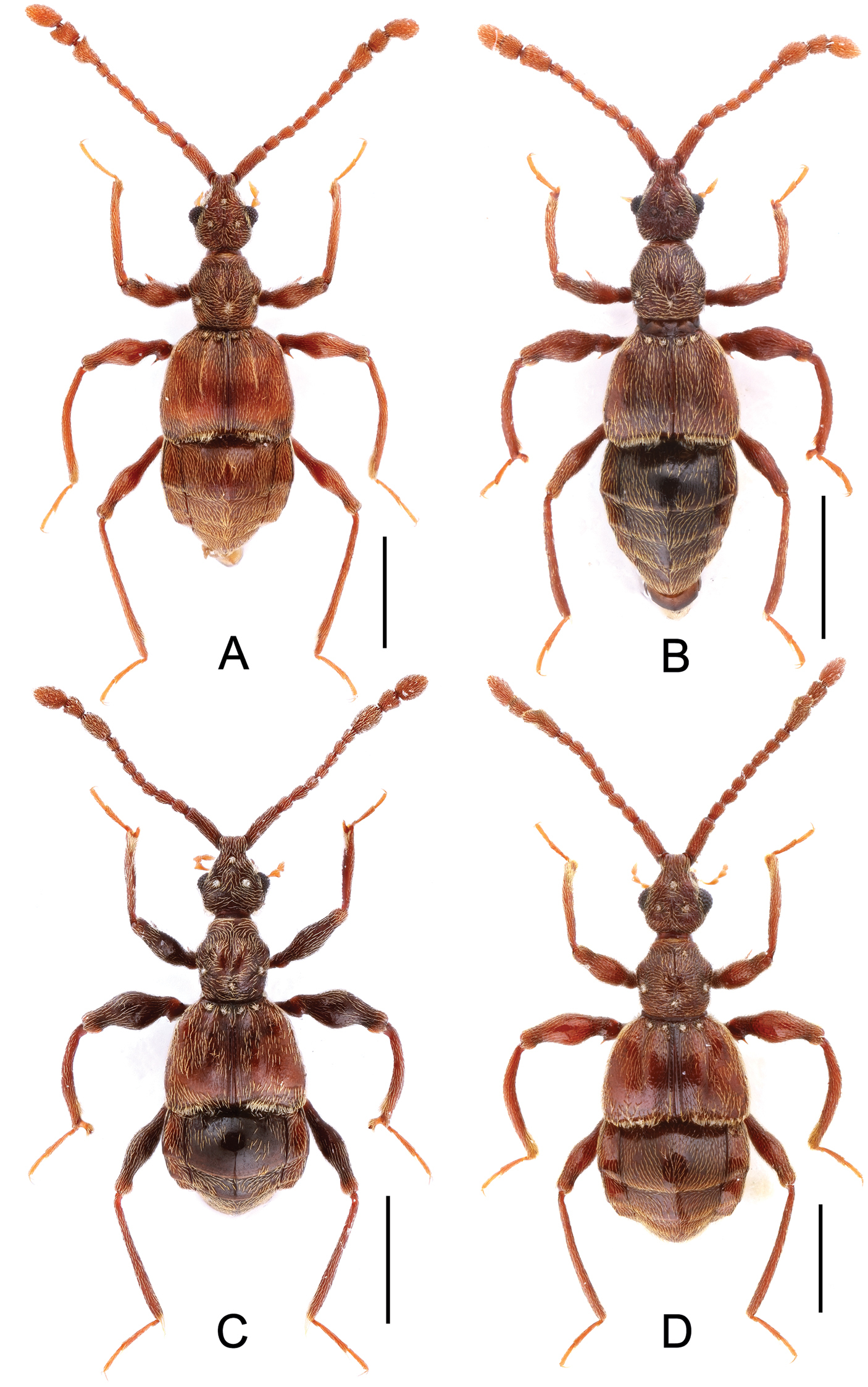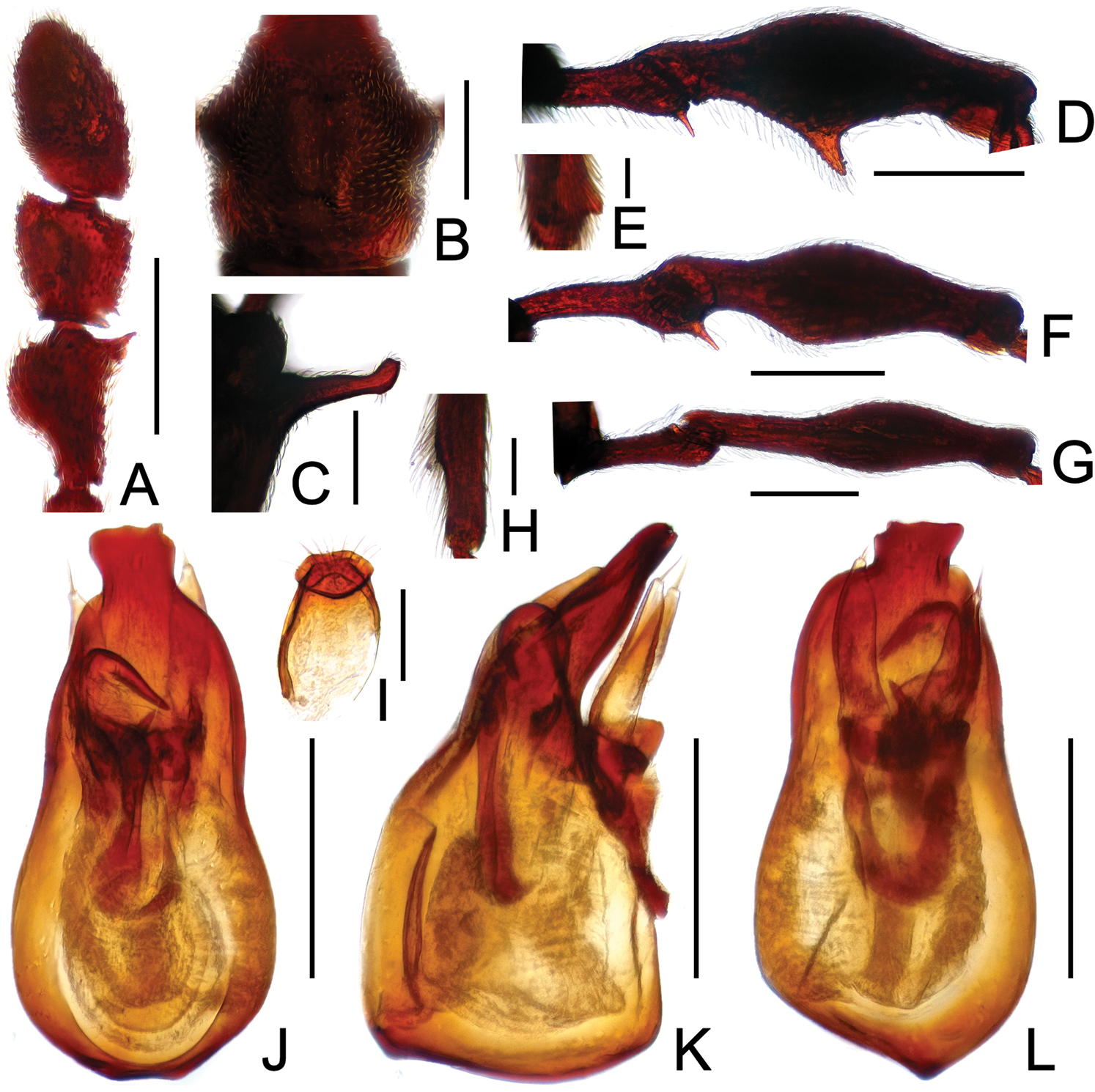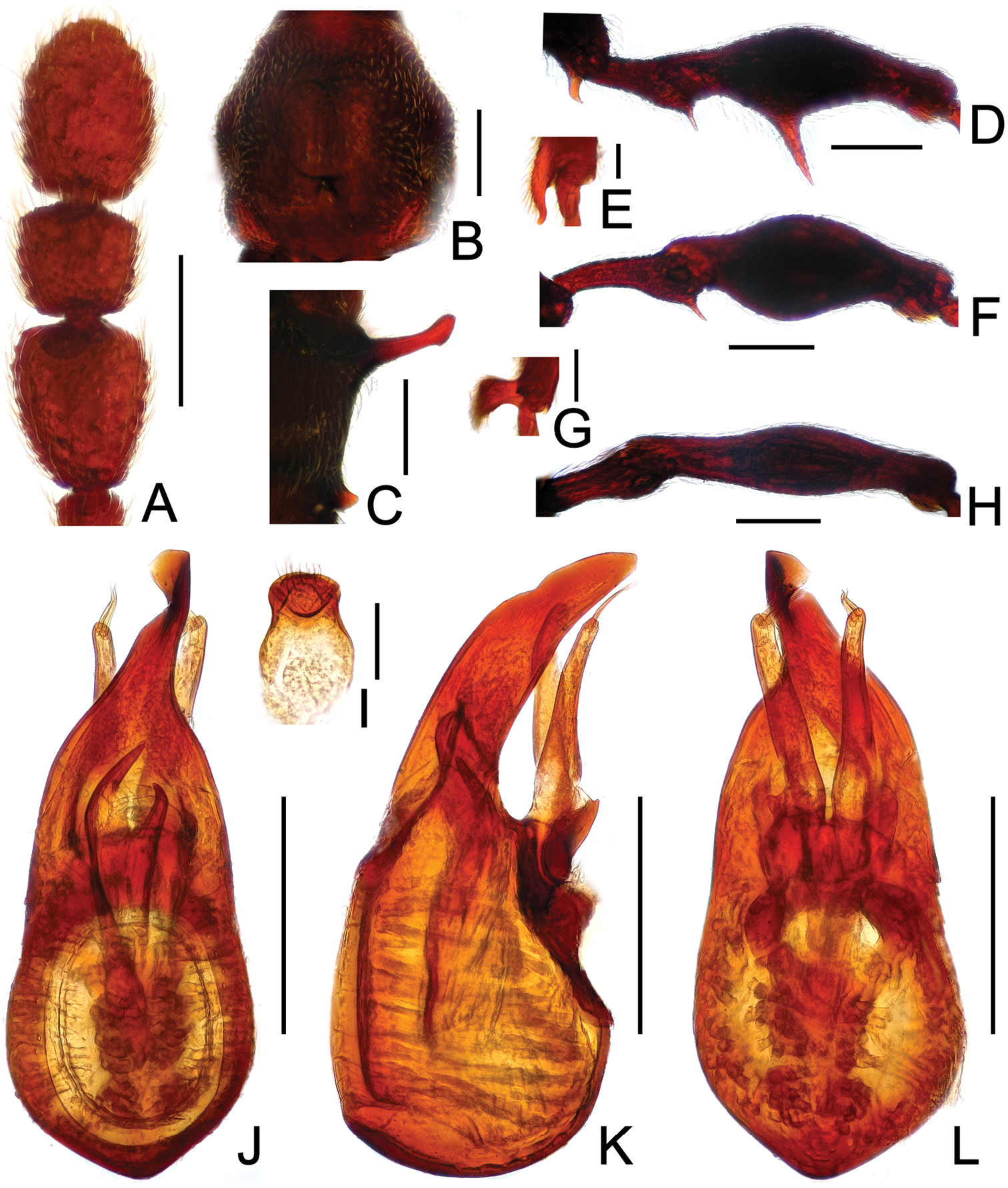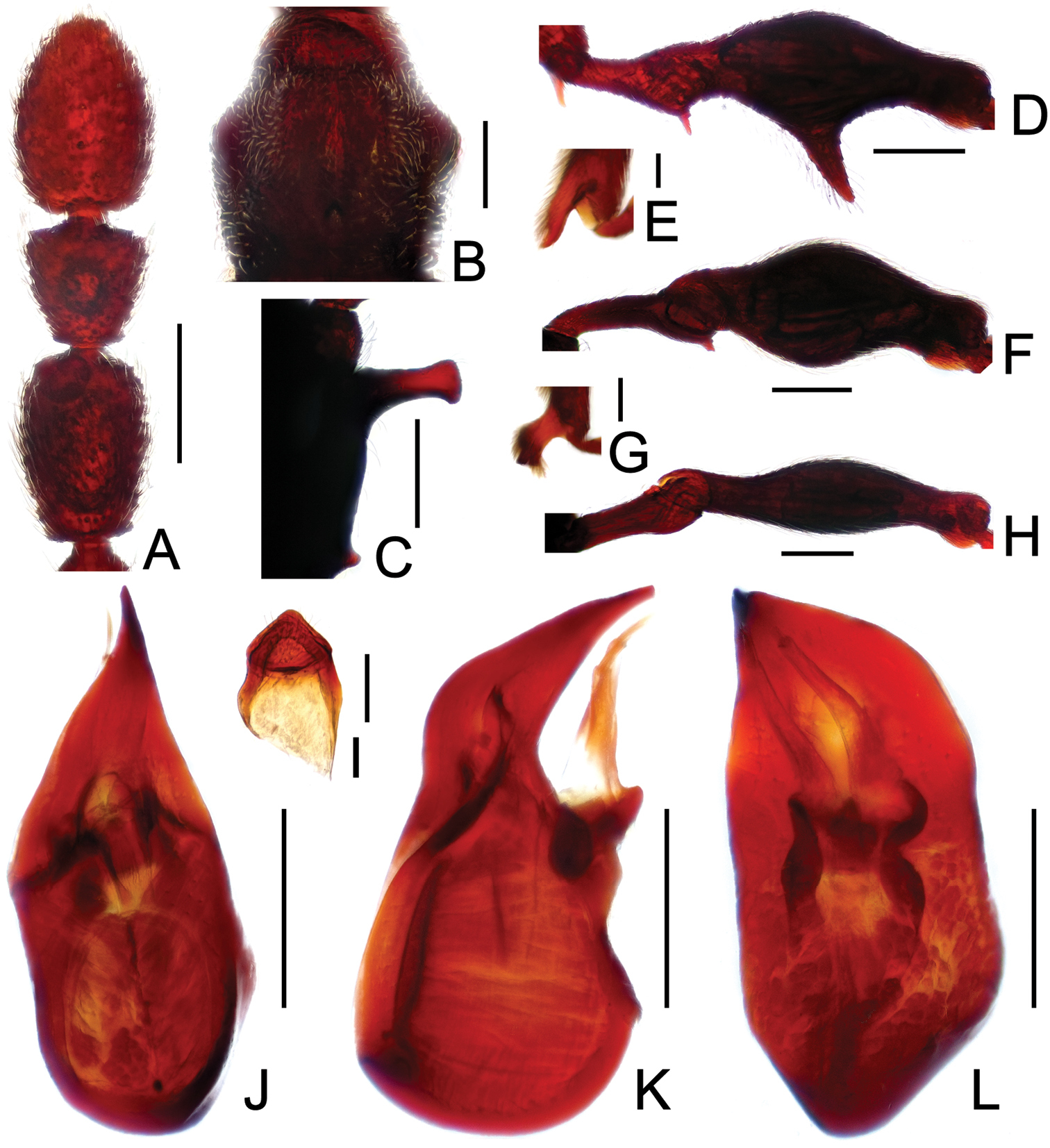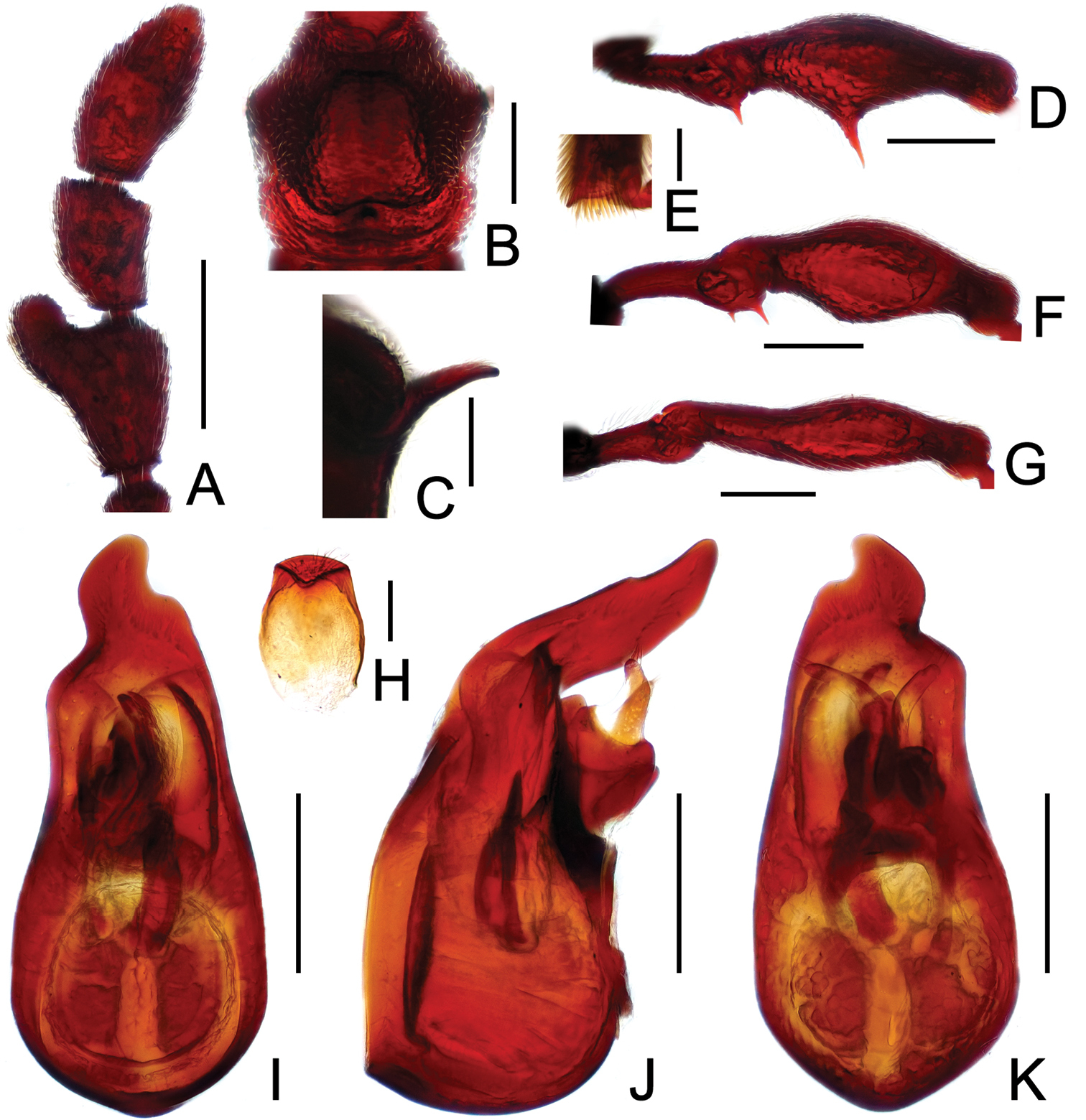






(C) 2012 Zi-Wei Yin. This is an open access article distributed under the terms of the Creative Commons Attribution License 3.0 (CC-BY), which permits unrestricted use, distribution, and reproduction in any medium, provided the original author and source are credited.
For reference, use of the paginated PDF or printed version of this article is recommended.
This paper is the first of a series that deals with Dr. Michael Schülke’s collection of Pselaphinae from China. The tyrine genera Labomimus Sharp, Linan Hlaváč and Pselaphodes Westwood are chosen for the first part. The study revealed fourteen new species, all described and illustrated: Labomimus cognatus Yin & Li, sp. n. (Yunnan), Labomimus dabashanus Yin & Li, sp. n. (Hubei, Shaanxi), Labomimus mirus Yin & Li, sp. n. (Yunnan), Labomimus paratorus Yin & Li, sp. n. (Shaanxi), Labomimus sarculus Yin & Li, sp. n. (Yunnan), Labomimus schuelkei Yin & Li, sp. n. (Shaanxi), Labomimus vespertilio Yin & Li, sp. n. (Yunnan), Linan tendothorax Yin & Li, sp. n. (Yunnan), Pselaphodes distincticornis Yin & Li, sp. n. (Yunnan), Pselaphodes erlangshanus Yin & Li, sp. n. (Sichuan), Pselaphodes flexus Yin & Li, sp. n. (Yunnan), Pselaphodes tibialis Yin & Li, sp. n. (Yunnan), Pselaphodes venustus Yin & Li, sp. n. (Yunnan) and Pselaphodes zhongdianus Yin & Li, sp. n. (Yunnan). Pselaphodes jizushanus Yin, Li & Zhao is recorded from a new locality in Yunnan and its aedeagus is newly illustrated; new province records for Pselaphodes nomurai Yin, Li & Zhao is provided. Labomimus torus (Yin, Li & Zhao), comb. n. is moved from Pselaphodes after an examination of the holotype. Species represented only by unassociated females are listed with label data.
Staphylinidae, Pselaphinae, taxonomy, new species, new combination, China
The Asian species of the Pselaphodes complex of genera (sensu
Recent access to the pselaphine collection of M. Schülke, which contains specimens collected during several expeditions by M. Schülke (Berlin, staphylinidologist) and D. W. Wrase (Berlin, carabidologist) to China, provided us an opportunity to work on a large number of yet undescribed tyrine species from that country. In this paper, members of the genera Labomimus Sharp, Linan Hlaváč and Pselaphodes Westwood are treated. The results are fourteen new species, one new record of known species and one new combination; sixteen species are represented only by female specimens, and are listed with their collecting data for future study. This information is reported herein.
The material referred to in this study is housed in the following public institution and private collection:
SNUC Insect Collection of Shanghai Normal University, Shanghai (Z.-W. Yin)
cSch private collection M. Schülke, Berlin
The Michael Schülke collection will eventually be moved to Museum für Naturkunde, Berlin (MNB).
Labels of the examined material are quoted verbatim if not mentioned otherwise; a slash (/) is used to separate lines on the same label, and a double slash (//) is used to separate different labels.
Holotype bears the following label: ‘HOLOTYPE [red] / xxx xxx [genus name, species name] / sp. n., Yin & Li / det., 2012, xxx [depository]’, and paratype bears a similar label except: ‘PARATYPE [yellow]’.
The terminology of the foveal system follows
Measurements are in millimeters. The following acronyms are used in the text: AL–length of the abdomen along the midline; AW–maximum width of the abdomen; BL–length of the body (= HL + PL + EL + AL); EL–length of the elytra along the sutural line; EW–maximum width of the elytra; HL–length of the head from the anterior clypeal margin to the occipital constriction; HW–width of the head across eyes; PL–length of the pronotum along the midline; PW–maximum width of the pronotum.
urn:lsid:zoobank.org:act:77BAE919-26BC-4D78-8094-5EED63B6C5BC
http://species-id.net/wiki/Labomimus_cognatus
Figs 1A, 2(3 ♂♂, 3 ♀♀). Holotype: ♂, labeled ‘CHINA Yunnan [CH07-11], Baoshan / Pref., Gaoligong Shan, m. Xiaoheishan / N.R., 35 km SE Tengchong, 2110 m, / 24°"50'16"N, 98°"45'43"E, decid forest, / litter, sifted, 30.V.2007, M. Schülke’ (cSch). Paratypes, 1 ♂, same label data as holotype (SNUC); 1 ♂, labeled ‘CHINA: Yunnan, Baoshan Pref., Gao- / ligong Shan, W pass, 32 km SE / Tengchong, 1600 m, 25°51'11"N, 98°44'27"E, cleft with devast. primary / forest, litter & mushr. sifted, 28.VIII. / 2009, leg. M. Schülke [CH09-14]’ (cSch); 1 ♀, same label data except ‘D.W. Wrase [14]’ (cSch); 1 ♀, same label data, except ‘W pass, 35 km / SE Tengchong, 2100 m (devast. prim. / dec. forest, litter, sifted) / 24°50'18"N, 98°45'43"E / 25-28.VIII.2009 D.W. Wrase [06]’ (SNUC); 1 ♀, same label data, except ‘litter, wood, mushrooms sifted, 25.VIII. / 2009, leg. M. Schülke [CH09-06]’ (cSch).
Reddish brown; length 3.18–3.48; postgenae nearly rounded; antennomeres IX–XI enlarged, IX–X modified in the male; pronotum with lateral margins moderately angularly expanded laterally; with short blunt metaventral processes; metacoxae spinose; aedeagus with symmetric median lobe.
Male (Fig. 1A). Length 3.18–3.41. Head longer than wide, HL 0.71–0.78, HW 0.65–0.71; eyes each composed of about 40 facets. Antennal clubs as in Fig. 2A. Pronotum (Fig. 2B) slightly longer than wide, PL 0.71–0.75, PW 0.66–0.71, with lateral margins moderately angularly expanded laterally. Elytra wider than long, EL 0.84–0.90, EW 1.12–1.35. Short metaventral processes with rounded apices (Fig. 2C). Protrochanters with small ventral spine, profemora with large ventral spine (Fig. 2D), protibiae with small apical tubercle (Fig. 2E); mesotrochanters (Fig. 2F) with tiny spine at ventral margin; metacoxae (Fig. 2G) with long hook-like protuberance at ventral margin, metatrochanters and metafemora simple. Abdomen broad at base and narrowed apically, AL 0.92–0.98, AW 1.23–1.37. Sternite IX as in Fig. 2H. Aedeagus length 0.50, with symmetric median lobe (Figs 2I–K).
Female. Similar to male in general; BL 3.25–3.48, HL 0.73–0.76, HW 0.65–0.66, PL 0.76–0.77, PW 0.71–0.72, EL 0.80–0.86, EW 1.34–1.41, AL 0.96–1.09, AW 1.41–1.46. Eyes each composed of about 27 facets. Antennae lacking modification; metaventral processes absent.
This is placed as a sister species of Labomimus vespertilio sp. n. described below. The two species share a similar general appearance, short metaventral process, similar placement of spines on the legs and a close aedeagal form. The two species can be readily separated by the smaller size, the symmetric antennomeres IX with a disc-like process and the median lobe has a narrower apex in Labomimus cognatus, while Labomimus vespertilio is larger in size, has strongly asymmetric antennomeres IX and has the aedeagus with median lobe much broader at apex.
Southwest China: Yunnan.
Individuals were sifted from leaf litter in deciduous forests.
The Latin word ‘cognatus’ means ‘related’, indicating a close relationship between the new species and Labomimus vespertilio described below.
Male habitus of Labomimus spp. A Labomimus cognatus B Labomimus dabashanus C Labomimus mirus D Labomimus paratorus. Scales: 1.0 mm.
Diagnostic features of Labomimus cognatus. A antenna B pronotum C median meteventral process, in lateral view D protrochanter and profemur E apical portion of protibia F mesotrochanter and mesofemur G metacoxa, metatrochanter and metafemur H sternite IX I aedeagus, in dorsal view J same, in lateral view K same, in ventral view. Scales (mm): A, B, D, F, G = 0.3; C, I, J, K = 0.2; H = 0.1; E = 0.05.
urn:lsid:zoobank.org:act:DBDF0116-0E4E-4C38-98E3-3609E077BE82
http://species-id.net/wiki/Labomimus_dabashanus
Figs 1B, 3(4 ♂♂, 5 ♀♀). Holotype: ♂, labeled ‘CHINA: W-Hubei (Daba Shan) / pass E of Mt. Da Shengnongjia, / 12 km NW Muyuping, 31°30'N, / 110°21'E, 22.VII.2001, / leg. M. Schülke [C01-13E] // dry creek vaelly, mixed deciduous forest, dead wood, mushrooms, / moss, 1950-2050 m (sifted) / [C01-13E]’ (cSch). Paratypes: 2 ♂♂, 3 ♀♀, same label data as holotype (cSch, SNUC); 1 ♂, labeled ‘CHINA: S-Shaanxi (Qinling Shan) / pass on rd. Zhouzhi-Foping, / 105 km SW Xi’an, N-slope / 1880 m, 33°44'N, / 107°25'E / leg. M. Schülke [C01-03] // 4.VII.2001, / shady rockwall base, moist / (sifted) [C01-03]’ (cSch); 2 ♀♀, labeled ‘CHINA: W-Hubei (Daba Shan) / muntain range NE Muyuping, pass 12 km N Muyuping, / 31°32'N, 110°26'E, 2380 m, / leg. M. Schülke [C01-15] // 17.VII 2001, / N pass, N-slope with young deciduous forest, bank of / small creek, moss (sifted) [C01-15]’ (cSch). All types also bear the following labels: ‘Sammlung / M. Schülke / Berlin // M. SCHÜLKE Coll. / Staphylinidae, Pselaphinae / Labomimus sp. 13 / S. Nomura det., 2005’.
Reddish brown; length 2.36–2.96; postgenae broadly expanded laterally; antennomeres IX–XI enlarged, IX–X modified in the male; pronotum with round lateral margins; with long metaventral processes; metacoxae simple; aedeagus with asymmetric median lobe.
Male (Fig. 1B). Length 2.85–2.96. Head slightly longer than wide, HL 0.63–0.66, HW 0.60–0.62; eyes each composed of about 25 facets. Antennal clubs as in Fig. 3A. Pronotum (Fig. 3B) as long as wide, PL and PW 0.57–0.59, with round lateral margins. Elytra wider than long, EL 0.69–0.71, EW 1.09–1.10. Metaventral processes long, broadened apically with truncate apices (Fig. 3C). Profemora with short triangular ventral spine (Fig. 3D), protibiae with small apical spur (Fig. 3E); mesotrochanters (Fig. 3F) with small spine and mesofemora angularly protuberant ventrally; metacoxae (Fig. 3G) with short ventral protuberance, metatrochanters and metafemora (Fig. 3H) simple. Abdomen broad at base and narrowed apically, AL 0.96–1.00, AW 1.16–1.20. Sternite IX as in Fig. 3I. Aedeagus length 0.57, with asymmetric median lobe elongate (Figs 3J–L).
Female. Similar to male in general; BL 2.36–2.50, HL 0.56–0.58, HW 0.49–0.50, PL 0.51–0.52, PW 0.50–0.52, EL 0.57–0.60, EW 1.09–1.10, AL 0.72–0.80, AW 1.19–1.22. Eyes each composed of about 20 facets. Antennae lacking modification; metaventral processes absent.
The new species is closest to Labomimus shibatai K. Sawada, 1961 by sharing the laterally expanded postgenae and rounded pronotal lateral margins. Apart from the clearly different aedeagal form, the two species can be separated by the much smaller body size, the transverse antennomeres X, and the elongate antennomeres IX being angularly expanded at anteromedial margin in Labomimus dabashanus. Labomimus shibatai is much larger in size (3.5–3.8 mm), has elongate antennomeres X and enlarged and unmodified antennomeres IX.
Central China: Hubei; Norwest China: Shaanxi.
Individuals were sifted from leaf litter and moss in deciduous forests.
Named after the type locality ‘Dabashan Mountain’.
Diagnostic features of Labomimus dabashanus. A antenna B pronotum C median meteventral process, in lateral view D protrochanter and profemur E apical portion of protibia F mesotrochanter and mesofemur G metatrochanter and metafemur H metacoxa I sternite IX J aedeagus, in dorsal view K same, in lateral view L same, in ventral view. Scales (mm): A, B, D, F, G = 0.3; C, J, K, L = 0.2; I = 0.1; E, H = 0.05.
urn:lsid:zoobank.org:act:B118D9BC-BFCD-4DFF-B508-39BB3AEEFFC7
http://species-id.net/wiki/Labomimus_mirus
Figs 1C, 4(6 ♂♂, 1 ♀). Holotype: ♂, labeled ‘CHINA (N-Yunnan) Dali Bai Nat. / Aut. Pref., Diancang Shan, 3 km / W Dali old town, pine forest at / “cloud road”, night upper chair- / list station, 24°41.1"N, 100°06.8'E / 2650-2750 m (needle/leaf litter) / 1.IX.2003 Wrase [19C] // Sammlung / M. Schülke / Berlin // M. SCHÜLKE Coll. / Staphylinidae, Pselaphinae / Labomimus sp. 6 / S. Nomura det., 2005’ (cSch). Paratypes: 1 ♂, same label data, except with additional label as ‘[C03-19A] pine needles, moss / (dry) in ditches, mushrooms, / 30.VIII.2003, leg. M. Schülke’ (SNUC); 4 ♂♂, labeled ‘CHINA: Yunnan [CH07-09], / Dali Bai Auton. Pref., Diancang Shan 45 / km NW Dali, 2730 m, 26°01'20"N, 99°53'17"E, creek valley, pines, ferns, / sifted, 29.V.2007, M. Schülke’ (cSch, SNUC); 1 ♀, same label data, except ‘25°41'09"N, 100°06'32"E, 3000- / 3200 m, cleft in mixed forest, litter, / debirs sifted, 27.V.2007, M. Schülke’(cSch).
Reddish brown; length 3.36–3.75; postgenae rounded; antennomeres IX–XI enlarged, IX–X modified in the male; pronotum with lateral margins moderately angulate laterally; with short sharp metaventral processes; metacoxae simple; aedeagus with median lobe nearly symmetric.
Male (Fig. 1C). Length 3.41–3.75. Head slightly longer than wide, HL 0.71–0.72, HW 0.65–0.68; eyes each composed of about 45 facets. Antennal clubs as in Fig. 4A. Pronotum (Fig. 4B) about as long as wide, PL 0.70–0.73, PW 0.65–0.71, with roundly angulate lateral margins. Elytra wider than long, EL 0.87–0.93, EW 1.38–1.40. Metaventral processes short, narrowed from base toward apex (Fig. 4C). Protrochanters with small ventral spine, profemora with large thick ventral spine (Fig. 4D); mesotrochanters (Fig. 4E) with small spine at ventral margin, mesotibiae (Fig. 4F) with short blunt apical tubercle; metatrochanters and metafemora (Fig. 4G) simple. Abdomen broad at base and narrowed apically, AL 1.13–1.37, AW 1.35–1.43. Sternite IX as in Fig. 4H. Aedeagus length 0.67, with broad median lobe elongate nearly symmetric (Figs 3I–K).
Female. Similar to male in general; BL 3.36, HL 0.71, HW 0.64, PL 0.66, PW 0.64, EL 0.74, EW 1.21, AL 1.25, 1.43. Eyes each composed of about 35 facets. Antennae lacking modification; metaventral processes absent.
The postgenae of the head being rounded and not laterally expanded quickly separates this species from Labomimus sichuanicus Hlaváč, Labomimus schuelkei sp. n. described below, Labomimus dabashanus and Labomimus shibatai. From the rest of the members of the genus, Labomimus mirus can be readily recognized by its characteristic antennal modification and aedeagus.
Southwest China: Yunnan.
Species were sifted from various kinds of leaf litter and moss in mixed forests.
Tha Latin word ‘mirus’ means ‘extraodinary, remarkable’, referring to the unique antennal modification and aedeagal form of this species.
Figure 4. Diagnostic features of Labomimus mirus. A antenna B pronotum C median meteventral process, in lateral view D protrochanter and profemur E mesotrochanter and mesofemur F apical portion of mesotibia G metatrochanter and metafemur H sternite IX I aedeagus, in dorsal view J same, in lateral view K same, in ventral view. Scales (mm): A, B, D, E, G = 0.3; C, I, J, K = 0.2; H = 0.1; F = 0.05.
urn:lsid:zoobank.org:act:AE6BCF63-0112-4CAE-9D52-FBFE72490A1B
http://species-id.net/wiki/Labomimus_paratorus
Figs 1D, 5(3 ♂♂). Holotype: ♂, labeled ‘China: Shaanxi, Qin Ling Shan / 108.47E, 33.51N, Mountain W / pass at Autoroute km 70, 47 km / 2500-2600 m, sifted / 26.-27.08.1995, leg. M. Schülke // Sammlung / M. Schülke / Berlin // M. SCHÜLKE Coll. / Staphylinidae, Pselaphinae / Labomimus sp. 5 / S. Nomura det., 2005’ (cSch). Paratypes: 1 ♂, same label data as holotype, with additional identification label ‘Labomimus Sharp sp. / det. Brachat 2. 99’ (SNUC); 1 ♂, labeled ‘CHINA (S-Shaanxi) Qingling Shan / mount. range W pass on rd. Xi’an / - Shagoujie, 45 km SSE Xi’an, / 33°52'N, 108°46'E, 2675 m / (N-slope, Abies, Betula, Larix, / subalp. meadows, along road) / 25.VII.2001 Wrase [20] // Sammlung / M. Schülke / Berlin // M. SCHÜLKE Coll. / Staphylinidae, Pselaphinae / Labomimus sp. 14 / S. Nomura det., 2005’ (cSch).
Reddish brown; length 3.55–3.87; postgenae rounded; antennomeres IX–XI enlarged, IX modified in the male; pronotum with lateral margins slightly angularly expanded laterally; metaventral processes roundly broadened apically; metacoxae simple; aedeagus with asymmetric median lobe.
Male (Fig. 1D). Length 3.55–3.87. Head longer than wide, HL 0.74–0.76, HW 0.66–0.69; eyes each composed of about 40 facets. Antennal clubs as in Fig. 5A. Pronotum (Fig. 5B) about as long as wide, PL 0.68–0.70, PW 0.69–0.71, with lateral margins slightly angularly expanded. Elytra wider than long, EL 0.92–0.93, EW 1.25–1.28. Metaventral processes moderately elongate, apically roundly enlarged (Fig. 5C). Procoxae with short thick ventral spine, protrochanters with small ventral spine, profemora with large blunt spine at ventral margin (Fig. 5D), protibiae (Fig. 5E) with small apical tubercle; mesotrochanters (Fig. 5F) with small spine at ventral margin, mesotibiae (Fig. 5G) with short truncate apical tubercle; metatrochanters and metafemora (Fig. 5H) simple. Abdomen broad at base and narrowed apically, AL 1.21–1.48, AW 1.40–1.43. Sternite IX as in Fig. 5I. Aedeagus length 0.81, median lobe elongate, asymmetric (Figs 5J–L).
Female. Unknown.
A reexamination of the holotype of Pselaphodes torus Yin, Li & Zhao clearly showed the presence of a median metaventral fovea in that species, a character state that is shared by Labomimus, Linan, and Indophodes Hlaváč of the Pselaphodes-complex. Combined with the short tarsomeres II not extending to beneath the III, the distinct frontal and vertexal foveae, and the presence of a pronotal median antebasal fovea, Pselaphodes torus is here moved to Labomimus, comb. n. Labomimus paratorus is placed closest to Labomimus torus, they share a similar general appearance, the placement of spines on the legs, and even similar aedeagal form. The two species can be separated only by reddish-brown body coloration and the short apical projections of pro- and mesotibiae in Labomimus paratorus, in contrast Labomimus torus has black body coloration and much longer apical projections of the first two pairs of tibiae.
Norwest China: Shaanxi.
Individuals were sifted from leaf litter of mixed forests.
The species name indicates a close relationship to Labomimus torus.
Diagnostic features of Labomimus paratorus. A antenna B pronotum C median meteventral process, in lateral view D procoxa, protrochanter and profemur E apical portion of protibia F mesotrochanter and mesofemur G apical portion of mesotibia H metatrochanter and metafemur I sternite IX J aedeagus, in dorsal view K same, in lateral view L same, in ventral view. Scales (mm): A, B, D, F, H = 0.3; C, J, K, L = 0.2; I = 0.1; E, G = 0.05.
urn:lsid:zoobank.org:act:88F4D2D6-C9B6-4B74-9CC4-472673FC4EBE
http://species-id.net/wiki/Labomimus_sarculus
Figs 6A, 7(2 ♂♂). Holotype: ♂, labeled ‘CHINA: Yunnan, Baoshan Pref., Gao- / ligong Shan, 32 km SE Tengchong, / 2150-2250 m, 24°51-53'N, 98°45'E, / devast. prim. and second. forest litter, / dead wood, mushrooms sifted, 26.VIII. / 2009, leg. M. Schülke [CH09-08/09]’ (cSch). Paratype: 1 ♂, same label data as holotype (cSch).
Reddish brown; length 2.89–3.02; postgenae nearly rounded; antennomeres IX–XI enlarged, IX–X modified in the male; pronotum with lateral margins slightly angularly expanded laterally; metaventral processes short and sharp; metacoxae with large hook-like ventral protuberance; aedeagus with symmetric median lobe.
Male (Fig. 6A). Length 2.89–3.02. Head longer than wide, HL 0.70–0.71, HW 0.66–0.69; eyes each composed of about 25 facets. Antennal clubs as in Fig. 7A. Pronotum (Fig. 7B) slightly longer than wide, PL 0.68–0.70, PW 0.64–0.65, with lateral margins slightly angularly expanded. Elytra wider than long, EL 0.75–0.76, EW 1.18–1.19. Metaventral processes short, narrowed apically with pointed apices (Fig. 7C). Protrochanters with small ventral spine, profemora with large sharp spine at ventral margin (Fig. 7D), protibiae (Fig. 7E) with distinct preapical apur; mesotrochanters (Fig. 7F) with indistinct tiny spine at ventral margin; metacoxae (Fig. 7G) with big hook-like protuberance at ventral margin, metatrochanters and metafemora simple. Abdomen broad at base and narrowed apically, AL 0.76–0.85, AW 1.23–1.26. Sternite IX as in Fig. 7H. Aedeagus length 0.60, median lobe symmetric, narrowed from base toward apex (Figs 7I–K).
Female. Unknown.
This species is placed near Labomimus cognatus and Labomimus vespertilio described below by sharing a similar habitus, the short median metaventral process and the protuberant metacoxae. Labomimus sarculus can be readily separated from both species by the unique modified antennomeres IX, longer apical spur of protibiae and the aedeagus has the median lobe medially straight at the apex, not concave.
Southwest China: Yunnan.
Individuals were sifted from leaf litter and mixed deadwood and mushrooms in a devastated primary and secondary forest.
The Latin word ‘sarculus’ means ‘a hoe’, referring to the uniquely modified antennomeres IX.
Male habitus of Labomimus and Linan spp. A Labomimus sarculus B Labomimus schuelkei C Labomimus vespertilio D Linan tendothorax. Scales: 1.0 mm.
Diagnostic features of Labomimus sarculus. A antenna B pronotum C median meteventral process, in lateral view D protrochanter and profemur E apical portion of protibia F mesotrochanter and mesofemur G metacoxa, metatrochanter and metafemur H sternite IX I aedeagus, in dorsal view J same, in lateral view K same, in ventral view. Scales (mm): A, B, D, F, G = 0.3; C, I, J, K = 0.2; H = 0.1; E = 0.05.
urn:lsid:zoobank.org:act:1616C90A-14ED-4941-A128-5AFA6E28028E
http://species-id.net/wiki/Labomimus_schuelkei
Figs 6B, 8(1 ♂). Holotype: ♂, labeled ‘China: Shaanxi, Qin Ling Shan / 110.06E, 34.27N / Hua Shan Mt. N Valley, 1200- / 1400 m, 118 km E Xi’an, sifted / 18.-20.08.1995, leg. M. Schülke // Eulasinus Sharp sp. / det. Brachat 2. 99 // Sammlung / M. Schülke / Berlin // M. SCHÜLKE Coll. / Staphylinidae, Pselaphinae / Labomimus sp. 4 / S. Nomura det., 2005’ (cSch).
Reddish brown; length 3.92; postgenae strongly expanded laterally; antennomeres IX–XI enlarged, IX–X modified in the male; pronotum with lateral margins nearly rounded; metaventral processes short; metacoxae simple; aedeagus with asymmetric median lobe.
Male (Fig. 6B). Length 3.92. Head longer than wide, HL 0.89, HW 0.78; eyes each composed of about 20 facets. Antennal clubs as in Fig. 8A. Pronotum (Fig. 8B) slightly longer than wide, PL 0.76, PW 0.70, with lateral margins nearly rounded. Elytra wider than long, EL 0.89, EW 1.34. Metaventral processes short, apically narrowed (Fig. 8C). Protrochanters with tiny ventral spine, profemora simple (Fig. 8D); mesotrochanters (Fig. 8E) with one big spine and one smaller spine at ventral margin; metacoxae with elongate protuberance (Fig. 8F), metatrochanters and metafemora (Fig. 8G) simple. Abdomen broad at base and narrowed apically, AL 1.38, AW 1.37. Sternite IX as in Fig. 8H. Aedeagus length 0.62, asymmetric median lobe narrow (Figs 8I–K).
Female. Unknown.
Labomimus schuelkei is placed close to Labomimus sichuanicus by sharing the postgenae being largely expanded laterally with a thickened posterior margin, and the strongly elongate antennomeres V–VIII. The two species can be readily separated by the large body size, the strongly modified antennomeres IX–X, and the aedeagus with the median lobe narrow dorsal-ventrally in Labomimus schuelkei, while Labomimus sichuanicus is much smaller (3.05–3.20 mm), has simple antennomeres IX–X, and has the aedeagus with a much broader median lobe (
Northwest China: Shaanxi.
Probably sifted from leaf litter in a forest.
Named after Michael Schülke, a well-known specialist in Staphylinidae, who kindly provided all the material used in this paper.
Diagnostic features of Labomimus schuelkei. A antenna B pronotum C median meteventral process, in lateral view D protrochanter and profemur E mesotrochanter and mesofemur F metatrochanter and metafemur G metacoxa H sternite IX I aedeagus, in dorsal view J same, in lateral view K same, in ventral view. Scales (mm): A, B, D, E, F = 0.3; C, I, J, K = 0.2; H, G = 0.1.
urn:lsid:zoobank.org:act:16AA692E-CA85-4705-A6A7-FB71A99A0C06
http://species-id.net/wiki/Labomimus_vespertilio
Figs 6C, 9(2 ♂♂, 5 ♀♀). Holotype: ♂, labeled ‘CHINA: Yunnan, Dali Bai Aut. Pref., / mount. range E Weishan, 12 km NE / Weishan, 25°17'02-15"N, 100°22' / 22-30"E, 2630-2660 m, scrub with / pines and bamboo, litter sifted, 15.IX. / 2009. leg. M. Schülke [CH09-54]’ (cSch). Paratypes: 1 ♂, 5 ♀♀, same label data as holotype (cSch, SNUC).
Reddish brown; length 3.34–3.52; postgenae nearly rounded; antennomeres IX–XI enlarged, VIII–X modified in the male; pronotum with lateral margins moderately angularly expanded laterally; with short blunt metaventral processes; metacoxae spinose; aedeagus with symmetric median lobe.
Male (Fig. 6C). Length 3.34–3.52. Head longer than wide, HL 0.70–0.75, HW 0.63–0.65; eyes each composed of about 30 facets. Antennal clubs as in Fig. 9A. Pronotum (Fig. 9B) slightly longer than wide, PL 0.71–0.74, PW 0.65–0.70, with lateral margins moderately angularly expanded laterally. Elytra wider than long, EL 0.75–0.81, EW 1.23–1.28. Short metaventral processes with rounded apices (Fig. 9C). Protrochanters with small ventral spine, profemora with large ventral spine (Fig. 9D), protibiae with distinct apical tubercle (Fig. 9E); mesotrochanters (Fig. 9F) with tiny spine at ventral margin; metacoxae (Fig. 9G) with long hook-like protuberance at ventral margin, metatrochanters and metafemora simple. Abdomen broad at base and narrowed apically, AL 1.18–1.22, AW 1.28–1.35. Sternite IX as in Fig. 9H. Aedeagus length 0.56, with symmetric median lobe (Figs 9I–K).
Female. Similar to male in general; BL 3.34–3.40, HL 0.72–0.73, HW 0.61–0.62, PL 0.72–0.73, PW 0.68–0.70, EL 0.73–0.74, EW 1.28–1.29, AL 1.17–1.20, AW 1.38–1.41. Eyes each composed of about 25 facets. Antennae lacking modification; metaventral processes absent.
This is placed as a sister species of Labomimus cognatus, sharing with it a number of character states (see comparative notes under Labomimus cognatus). The two species can be separated by the larger body size, the strongly asymmetric antennomeres IX, and the aedeagus with much broader apex in Labomimus vespertilio, while Labomimus cognatus is smaller in body size, has symmetric antennomeres IX with a disc-like process, and has the aedeagus with a much narrower apex. Other than the aforementioned characters, the two species also share with Labomimus sarculus the lateral rows of dense setae extending from frontal rostrum base to head base, and the three species seem toform a small species-complex. For separation of Labomimus sarculus from Labomimus cognatus and Labomimus vespertilio see the comparative notes under that species.
Southwest China: Yunnan.
Adults were from sifted leaf litter in a scrub forest with pines and bamboo.
The Latin word ‘vespertilio’ means ‘a bat’, referring to the bat-like apical part of the aedeagal median lobe.
Diagnostic features of Labomimus vespertilio. A antenna B pronotum C median meteventral process, in lateral view D protrochanter and profemur E apical portion of protibia F mesotrochanter and mesofemur G metacoxa, metatrochanter and metafemur H sternite IX I aedeagus, in dorsal view J same, in lateral view K same, in ventral view. Scales (mm): A, B, D, F, G = 0.3; C, I, J, K = 0.2; H = 0.1; E = 0.05.
urn:lsid:zoobank.org:act:3B08AD2E-62ED-4031-96EE-EB853063EA33
http://species-id.net/wiki/Linan_tendothorax
Figs 6D, 10(3 ♂♂, 14 ♀♀). Holotype: ♂, labeled ‘CHINA: Yunnan, Lincang Pref., Xue / Shan, 11 km ENE Lincang, 2510 m, / 23°55'01"N, 100°11'17.5"E, second. / pine forest with Rhodod., small cleft with water, litter & mushrooms sifted, / 10.IX.2009, leg. M. Schülke [CH09-39]’ (cSch). Paratypes: 1 ♂, 7 ♀♀, same label data as holotype (cSch, SNUC); 1 ♀, same label data, except ‘D.W. Wrase’ (cSch); 3 ♀♀, labeled ‘CHINA: Yunnan, Lincang Pref., / Laobei Shan, Wei Bo Shan pass, / 24°08'16"N, 99°42'53"E, 2375 m, / creek valley, devastated second. / decid. forest, litter & moss sifted, 8.IX.2009, leg. M. Schülke [CH09-35]’ (cSch); 3 ♀♀, labeled ‘CHINA (Yunnan) Lincang Pref., / Wuliang Shan, old pass road, W-side, / 2200 m (small creek valley with primary / forest remnant, litter, debris sifted) / 24°42'58.6"N, 100°29'52"E / 12.IX.2009 D.W.Wrase’ (cSch); 1 ♂, labeled ‘CHINA: Yunnan, Pu’er Pref., / Ailao Shan, 37 km NW Jingdong, / 24°45'12"N, 100°41'24.5"E, 2300 m, / devastated forest remnant, litter & / dead wood sifted, 13.IX.2009, / leg. M. Schülke [CH09-48]’ (cSch).
Reddish brown; length 2.80–2.95; postgenae rounded; antennomeres IX–XI enlarged, IX modified in the male; pronotum with lateral margins roundly expanded basolaterally; with short blunt metaventral processes; metacoxae spinose; aedeagus with asymmetric median lobe.
Male (Fig. 6D). Length 2.80–2.95. Head longer than wide, HL 0.65–0.66, HW 0.59–0.60; eyes each composed of about 17 facets. Antennal clubs as in Fig. 10A. Pronotum (Fig. 10B) about as long as wide, PL 0.61–0.62, PW 0.59–0.60, with round lateral margins. Elytra wider than long, EL 0.71–0.74, EW 1.08–1.09. Short metaventral processes with rounded apices (Fig. 10C). Protrochanters and profemora simple (Fig. 10D), protibiae with distinct small apical tubercle (Fig. 10E); mesotrochanters (Fig. 10F) with blunt triangular spine at ventral margin; metacoxae (Fig. 10G) with hook-like protuberance at ventral margin, metatrochanters and metafemora simple. Abdomen broad at base and narrowed apically, AL 0.83–0.93, AW 1.14–1.19. Sternite IX as in Fig. 10H. Aedeagus length 0.60, with asymmetric median lobe (Figs 10I–K).
Female. Similar to male in general; BL 2.81–2.92, HL 0.64–0.66, HW 0.58–0.59, PL 0.60–0.62, PW 0.60–0.62, EL 0.70–0.72, EW 1.16–1.19, AL 0.87–0.92, AW 1.22–1.25. Eyes each composed of about 16 facets. Antennae lacking modification; metaventral processes absent.
Linan tendothorax is placed as a member of the Labomimus cardialis species-group (sensu
Southwest China: Yunnan.
Individuals were sifted from mixed litter, moss, debris and dead wood in primary or secondary deciduous forests.
The species name is combined from the Latin stem ‘tend’ and Greek word ‘thorax’, referring to the unique basolaterally extended pronotum of the new species.
Diagnostic features of Linan tendothorax. A antenna B pronotum C median meteventral process, in lateral view D protrochanter and profemur E apical portion of protibia F mesotrochanter and mesofemur G metacoxa, metatrochanter and metafemur H sternite IX I aedeagus, in dorsal view J same, in lateral view K same, in ventral view. Scales (mm): A, B, D, F, G = 0.3; C, I, J, K = 0.2; H = 0.1; E = 0.05.
urn:lsid:zoobank.org:act:68CE4309-47C1-40AD-A7B1-2EA84A398A4F
http://species-id.net/wiki/Pselaphodes_distincticornis
Figs 11A, 12(2 ♂♂, 1 ♀). Holotype: ♂, labeled ‘CHINA: Yunnan, Dali Bai Aut. Pref. / 36 km N Dali, ruderal pasture wtih / pines and shrubs, 26°01'20"N, / 100°08'14"E, 2158 m, litter sifted / under pines and shrubs, 24.VIII.2009, / leg. M. Schülke [CH09-04]’ (cSch). Paratype: 1 ♂, same label data as holotype (SNUC); 1 ♀, same label data sa holotype, except ‘D.W. Wrase [04]’.
Reddish brown; length 2.74–2.88; postgenae rounded; antennomeres IX–XI enlarged, IX modified in the male; pronotum with lateral margins roundly expanded laterally; with long thick metaventral processes; metacoxae simple; aedeagus with asymmetric median lobe elongate.
Male (Fig. 11A). Length 2.74–2.88. Head longer than wide, HL 0.59–0.60, HW 0.58–0.59; eyes each composed of about 40 facets. Antennal clubs as in Fig. 12A. Pronotum (Fig. 12B) about as long as wide, PL 0.58–0.59, PW 0.58–0.60, with round lateral margins. Elytra wider than long, EL 0.72–0.73, EW 1.11–1.12. Long metaventral processes with truncate apices (Fig. 12C). Protrochanters and profemora simple (Fig. 12D), protibiae with short apical tubercle (Fig. 12E); mesotrochanters (Fig. 12F) with small spine at ventral margin; metatrochanters and metafemora (Fig. 12G) simple. Abdomen broad at base and narrowed apically, AL 0.85–0.96, AW 1.11–1.14. Sternite IX as in Fig. 12H. Aedeagus length 0.71, with asymmetric median lobe distinctively elongate (Figs 12I–K).
Female. Similar to male in general; BL 2.79, HL 0.64, HW 0.58, PL 0.59, PW 0.59, EL 0.62, EW 1.16, AL 0.94, AW 1.22. Eyes each composed of about 30 facets. Metaventral processes absent.
The unmodified antennal clubs are shared in Pselaphodes fengtingae Yin, Li et Zhao (Zhejiang, Jiangxi) and Pselaphodes parvus Yin, Li et Zhao (Guizhou). Pselaphodes distincticornis can be separated from bothspeciesby the larger size, the simple protrochanters and profemora, and the distinctively asymmetric and elongate median lobe of the aedeagus. Both Pselaphodes fengtingae and Pselaphodes parvus have the protrochanters with a small ventral spine, and the profemora with a larger spine at the ventral margin, and have the aedeagus with an asymmetric but much shorter median lobe.
Southwest China: Yunnan.
Species were sifted from leaf litter under pines and shrubs in a ruderal pasture.
Species name combined from Latin stems ‘distinct’ and ‘corn’, referring to the large median metaventral processes of the new species.
Male habitus of Pselaphodes spp. A Pselaphodes distincticornis B Pselaphodes erlangshanus C Pselaphodes flexus. Scales: 1.0 mm.
Diagnostic features of Pselaphodes distincticornis. A antenna B pronotum C median meteventral process, in lateral view D protrochanter and profemur E apical portion of protibia F mesotrochanter and mesofemur G metatrochanter and metafemur H sternite IX I aedeagus, in dorsal view J same, in lateral view K same, in ventral view. Scales (mm): A, B, C, D, F, G, I, J, K = 0.2; H = 0.1; E = 0.05.
urn:lsid:zoobank.org:act:ABAFBD58-6774-4127-A007-652A5C24A7A1
http://species-id.net/wiki/Pselaphodes_erlangshanus
Figs 11B, 13(2 ♂♂). Holotype: ♂, labeled ‘CHINA: W-Sichuan 1999 / Ganzi Tibet. Aut. Pref., Luding Co. / W Erlanshan-pass, 2600 m / 7 km SSE Luding, 29°51'N, / 102°15'E, Laub+Nadelstreu, Pilze / 22. VI., leg. M. Schülke // Sammlung / M. Schülke / Berlin // Labomimus Sharp sp. / det. Brachat 2.09 // M. SCHÜLKE Coll. / Staphylinidae, Pselaphinae / Lasinus sp. 1 / S. Nomura det., 2005’ (cSch). Paratype: 1 ♂, same label data as holotype, except ‘det. Brachat 4.01’ (cSch).
Reddish brown; length 3.29–3.78; postgenae nearly rounded; antennomeres IX–XI enlarged, IX modified in the male; pronotum with lateral margins slightly angularly expanded laterally; with long metaventral processes apically narrowed; metacoxae simple; aedeagus with asymmetric median lobe.
Male (Fig. 11B). Length 3.29–3.78. Head longer than wide, HL 0.74–0.78, HW 0.65–0.68; eyes each composed of about 30 facets. Antennal clubs as in Fig. 13A. Pronotum (Fig. 13B) about as long as wide, PL 0.70–0.72, PW 0.68–0.69, with lateral margins slightly angularly expanded laterally. Elytra wider than long, EL 0.87–0.90, EW 1.34–1.37. Long metaventral (Fig. 13C) processes thick at base, narrowed apically. Protrochanters with small ventral spine, profemora with long sharp spine at ventral margin (Fig. 13D), protibiae with distinct short apical spur (Fig. 13E); mesotrochanters with large and another much smaller spine at ventral margin, mesofemora with tiny ventral spine (Fig. 13F); metatrochanters and metafemora (Fig. 13G) simple. Abdomen broad at base and narrowed apically, AL 0.98–1.00, AW 1.35–1.38. Sternite IX as in Fig. 13H. Aedeagus length 0.65, with asymmetric median lobe (Figs 13I–K).
Female. Unknown.
This species may be related to Pselaphodes flexus and Pselaphodes zhongdianus (both described below) by sharing a similar general habitus, elongate antennomeres IX–XI, and a somewhat similar aedeagal form. Pselaphodes erlangshanus can be readily separated from Pselaphodes flexus by the larger size, the mesotrochanters with two ventral spines, and quite different form of the metaventral processes. The form of the antennomeres IX and aedeagus provide a quick separation of the new species from Pselaphodes zhongdianus.
Southwest China: Sichuan.
Individuals were sifted from leaf litter in a coniferous forest.
Named after the type locality.
Diagnostic features of Pselaphodes erlangshanus. A antenna B pronotum C median meteventral process, in lateral view D protrochanter and profemur E apical portion of protibia F mesotrochanter and mesofemur G metatrochanter and metafemur H sternite IX I aedeagus, in dorsal view J same, in lateral view K same, in ventral view. Scales (mm): A, B, D, F, G = 0.3; C, I, J, K = 0.2; H = 0.1; E = 0.05.
urn:lsid:zoobank.org:act:00C65770-8F24-4C21-A177-070255101FD4
http://species-id.net/wiki/Pselaphodes_flexus
Figs 11C, 14(1 ♂, 7 ♀♀). Holotype: ♂, labeled ‘CHINA (N-Yunnan) Lijiang Naxi / Aut. Co., E Yulongxue Shan, / 30 km N Lijiang, 2800-2900 m / 25°09.0'N, 100°14.9'E (creek / valley, secondary mixed forest) / 13.VIII.2003 Wrase [01] // Sammlung / M. Schülke / Berlin // M. SCHÜLKE Coll. / Staphylinidae, Pselaphinae / Labomimus sp. 9 / S. Nomura det., 2005’ (cSch). Paratypes: 3 ♀♀, same label data as holotype, except ‘Labomimus sp. 7 / S. Nomura det., 2005’; 4 ♀♀, same label data, except ‘13.VIII.2003, M. Schülke, (cSch, SNUC).
Reddish brown; length 2.87; postgenae rounded; antennomeres IX–XI enlarged, IX modified in the male; pronotum with lateral margins slightly angularly expanded laterally; with long metaventral processes apically narrowed; metacoxae simple; aedeagus with asymmetric median lobe.
Male (Fig. 11C). Length 2.87. Head longer than wide, HL 0.66, HW 0.60; eyes each composed of about 25 facets. Antennal clubs as in Fig. 14A. Pronotum (Fig. 14B) about as long as wide, PL 0.65, PW 0.63, with lateral margins slightly angularly expanded laterally. Elytra wider than long, EL 0.81, EW 1.12. Long metaventral (Fig. 14C) processes narrowed apically. Protrochanters with small ventral spine, profemora with big sharp spine at ventral margin (Fig. 14D), protibiae with broad triangular spur (Fig. 14E); mesotrochanters with small spine at ventral margin, mesofemora simple (Fig. 14F); metatrochanters and metafemora (Fig. 14G) simple. Abdomen broad at base and narrowed apically, AL 0.75, AW 1.23. Sternite IX as in Fig. 14H. Aedeagus length 0.60, with asymmetric median lobe (Figs 14I–K).
Female. Unknown.
As discussed above, this species may be related to Pselaphodes erlangshanus and Pselaphodes zhongdianus by sharing a similar general habitus, elongate antennomeres IX–XI, and a somewhat similar aedeagal form. Pselaphodes flexus can be separated from Pselaphodes erlangshanus by the smaller size, the mesotrochanters with single ventral spine, and much thinner metaventral process. The nearly symmetrically cylindrical antennomeres IX of Pselaphodes flexus readily separate it from Pselaphodes zhongdianus, whose antennomeres IX are strongly roundly and projecting anterolaterally.
Southwest China: Yunnan.
The individual was sifted from a secondary mixed forest in a ravine.
The Latin word ‘flexus’ means ‘curved, bent, twisting’, referring to the curved terminal antennomere of the new species.
Diagnostic features of Pselaphodes flexus. A antenna B pronotum C median meteventral process, in lateral view D protrochanter and profemur E apical portion of protibia F mesotrochanter and mesofemur G metatrochanter and metafemur H sternite IX I aedeagus, in dorsal view J same, in lateral view K same, in ventral view. Scales (mm): A, B, D, F, G = 0.3; C, I, J, K = 0.2; H = 0.1; E = 0.05.
http://species-id.net/wiki/Pselaphodes_jizushanus
Figs 15A, 161 ♂, labeled ‘CHINA: Yunnan [CH07-15], Baoshan / Pref., Gaoligong Shan, 29 km ESE / Tengchong, 24°55'37"N, / 98°45'09"E, / 2350 m, dev. decid. forest, litter, wood, / fungi sifted, 1.VI.2007, M. Schülke’ (cSch).
Yin et al. 2011: 471; Figs 15A, 16. Measurements: BL 3.10, HL 0.63, HW 0.59, PL 0.63, PW 0.62, EL 0.80, EW 1.14, AL 1.04, AW 1.12; eyes each composed of about 40 facets. Aedeagus length 0.51, with slightly asymmetrical median lobe (Figs 16J–L).
Southwest China: Yunnan.
Notes. This species was originally described based on a single male (Type-locality: Jizushan Mountain, ca. 25°57'37"N, 100°22'44"E, alt. 2400 m). The aedeagus of the holotype was unfortunately lost. Here we record a second male specimen of this species from Tengchong, Gaoligong Mountain, about 200 km southwest from the type locality, and have illustrated its aedeagus.
Male habitus of Pselaphodes spp. A Pselaphodes jizushanus B Pselaphodes tibialis C Pselaphodes venustus D Pselaphodes zhongdianus. Scales: 1.0 mm.
Diagnostic features of Pselaphodes jizushanus. A antenna B pronotum C median meteventral process, in lateral view D protrochanter and profemur E apical portion of protibia F mesotrochanter and mesofemur G metacoxa, metatrochanter and metafemur H apical portion of metatibia I sternite IX J aedeagus, in dorsal view K same, in lateral view L same, in ventral view. Scales (mm): A, B, D, F, G, J, K, L = 0.3; C = 0.2; H, I = 0.1; E = 0.05.
http://species-id.net/wiki/Pselaphodes_nomurai
(20 ♂♂, 18 ♀♀). 2 ♂♂, labeled ‘CHINA: Border Shaanxi - / Sichuan (Daba Shan), pass 20 km / SSE Zhenping, 1700-1800 m, / 31°44'N, 109°35'E, 9.VII.2001, / leg. M. Schülke [C01-07] // young dry mixed forest, / field edge, small creek valley / moss sifted [C01-07]’; 3 ♂♂, 2 ♀♀, same label data, except ’12.VII.2001’; 11 ♂♂, 13 ♀♀, same label data, except ‘Wrase [07]’; 3 ♂♂, 1 ♀, labeled ‘CHINA: S-Shaanxi (Qingling Shan) / pass on rd. Zhouzhi-Foping, / 105 km SW Xi’an, N-slpoe, / 1700 m, 33°46'N, 107°58'E / leg. M. Schülke [C01-02] // 3.VII.2001, / small creek valley, mixed / deciduous forest, moss / (sifted) [C01-02]’; 1 ♂, labeled ‘CHINA: S-Shaanxi (Qingling Shan) / river bank above Houzhenzi, / 115 km WSW Xi’an, / 1450 m, 33°50'N, 107°47'E, leg. M. Schülke [C01-06] // 5.VII.2001, / gravel bank (floating), / mixed deciduous forest, moss, / mushrooms (sifted) [C01-06]’ (all above specimens bear the following label: ‘M. SCHÜLKE Coll. / Staphylinidae, Pselaphinae / Labomimus sp. 11 / S. Nomura det., 2005’); 2 ♀♀, labeled ‘CHINA: W-Hubei (Daba Shan) / creek valley 8 km NW Muyuping, / 31°29'N, 110°22'E, 1550- / 1650 m, 18.VII.2001, / leg. M. Schülke [C01-16A] // creek valley, deciduous / forest, moss / (sifted) [C01-16A] // M. SCHÜLKE Coll. / Staphylinidae, Pselaphinae / Labomimus sp. 12 / S. Nomura det., 2005’ (all cSch). All specimens also bear the following label: ‘Sammlung / M. Schülke / Berlin // Pselaphodes nomurai / Yin, Li & Zhao, 2010 / det. Yin & Li, 2012’.
Yin et al., 2011: 479 (key); Yin et al., 2010: 21.
Southwest China: Shaanxi; Central China: Henan, Hubei (new provincial record).
urn:lsid:zoobank.org:act:AAEA7BAB-9AB1-45E3-B63F-83E97F51FD79
http://species-id.net/wiki/Pselaphodes_tibialis
Figs 15B, 17(2 ♂♂). Holotype: ♂, labeled ‘CHINA: Yunnan [CH07-09], / Dali Bai Aut. Pref., Diancang Shan 45 / km NW Dali, 2730 m, 26°01'20"N, 99°53'17"E, creek valley, pines, ferns, / sifted, 29.V.2007, M. Schülke’ (cSch). Paratype: 1 ♂, same label data as holotype (cSch).
Reddish brown; length 2.52–2.58; postgenae slightly angulate posterolaterally; antennomeres IX–XI enlarged, IX modified in the male; pronotum with lateral margins slightly angularly expanded laterally; with metaventral processes apically enlarged; metacoxae simple; aedeagus with asymmetric median lobe.
Male (Fig. 15B). Length 2.52–2.58. Head longer than wide, HL 0.58–0.59, HW 0.54–0.55; eyes each composed of about 40 facets. Antennal clubs as in Fig. 17A. Pronotum (Fig. 17B) about as long as wide, PL 0.54–0.55, PW 0.54–0.56, with lateral margins slightly angularly expanded laterally. Elytra wider than long, EL 0.68–0.71, EW 0.99–1.00. Long metaventral (Fig. 17C) processes broadened apically. Procoxae with sharp ventral tooth, protrochanters with short thin ventral spine, profemora with long sharp spine at ventral margin (Fig. 17D), protibiae with distinct apical spur (Fig. 17E); mesotrochanters with small spine at ventral margin, mesofemora simple (Fig. 17F), mesotibiae (Fig. 17G) with big apical projection; metatrochanters and metafemora (Fig. 17H) simple. Abdomen broad at base and narrowed apically, AL 0.72–0.73, AW 1.00–1.02. Sternite IX as in Fig. 17I. Aedeagus length 0.53, with asymmetric median lobe (Figs 17J–L).
Female. Unknown.
The resemblance in general habitus, antennal modification, placement of spines on the legs, and the shared modified pro- and mesotibiae place Pselaphodes tibialis closest to Pselaphodes venustus sp. n. described below. The two species can be separated by the smaller body size, the metaventral process being much thinner, and different aedeagal form in Pselaphodes tibialis, while Pselaphodes venustus is larger in size (3.07–3.34) and the metaventral process are much stouter.
Southwest China: Yunnan.
Individuals were sifted from mixed leaf litter in a ravine.
The specific name refers to the modifications present on the pro- and mesotibiae.
Diagnostic features of Pselaphodes tibialis. A antenna B pronotum C median meteventral process, in lateral view D procoxa, protrochanter and profemur E apical portion of protibia F mesotrochanter and mesofemur G apical portion of mesotibia H metatrochanter and metafemur I sternite IX J aedeagus, in dorsal view K same, in lateral view L same, in ventral view. Scales (mm): A, B, C, D, F, H, J, K, L = 0.2; I = 0.1; E, G = 0.05.
urn:lsid:zoobank.org:act:892D0215-8B5D-4CE0-8CDA-6BE661BC1414
http://species-id.net/wiki/Pselaphodes_venustus
Figs 15C, 18(1 ♂, 1 ♀). Holotype: ♂, labeled ‘CHINA (Yunnan) Dali Bai Aut. Pref., Jizu Shan, summit plateau, / 37 km NE Dali 3150 m, (mixed / forest, sifted from litter, moss) / 25°58'30"N, 100°21'36"E / 5.IX.2009 DW Wrase [28]’ (cSch). Paratype: 1 ♀, same label data, except ‘leg. M. Schülke [CH09-28]’ (cSch).
Reddish brown; length 3.07–3.34; postgenae rounded; antennomeres IX–XI enlarged, IX modified in the male; pronotum with lateral margins roundly expanded laterally; with stout metaventral processes apically broadened; metacoxae simple; aedeagus with asymmetric median lobe.
Male (Fig. 17C). Length 3.07. Head slightly longer than wide, HL 0.65, HW 0.60; eyes each composed of about 30 facets. Antennal clubs as in Fig. 18A. Pronotum (Fig. 18B) slightly longer than wide, PL 0.65, PW 0.61, with lateral margins roundly expanded laterally. Elytra wider than long, EL 0.83, EW 1.16. Metaventral processes stout with enlarged apices (Fig. 18C). Procoxae with sharp ventral tooth, protrochanters with short thin ventral spine, profemora with large spine at ventral margin (Fig. 18D), protibiae with distinct apical spur (Fig. 18E); mesotrochanters with small spine at ventral margin, mesofemora simple (Fig. 18F), mesotibiae (Fig. 18G) with big apical projection; metatrochanters and metafemora (Fig. 18H) simple. Abdomen broad at base and narrowed apically, AL 0.94, AW 1.20. Sternite IX as in Fig. 18I. Aedeagus length 0.65, with asymmetric median lobe (Figs 18J–L).
Female. Similar to male in general; BL 3.34, HL 0.68, HW 0.63, PL 0.65, PW 0.60, EL 0.83, EW 1.19, AL 1.18, AW 1.34. Eyes each composed of about 30 facets. Metaventral processes absent.
The differences in body size and forms of the tibial modifications between Pselaphodes venustus and Pselaphodes tibialis were thought to be intraspecific variation before suspicions arose, and dissections of the genital segments of both species were done. Now it is clear that Pselaphodes venustus represents a distinct species. It can be readily separated from Pselaphodes tibialis by the larger size, the much stouter metaventral processes and, primarily, the aedeagal form.
Southwest China: Yunnan.
Species were sifted from leaf litter and moss in a mixed forest.
The Latin word ‘venustus’ means ‘attractive in appearance’, with regard to the strong modifications of the pro- and mesotibiae.
Diagnostic features of Pselaphodes venustus. A antenna B pronotum C median meteventral process, in lateral view D procoxa, protrochanter and profemur E apical portion of protibia F mesotrochanter and mesofemur G apical portion of mesotibia H metatrochanter and metafemur I sternite IX J aedeagus, in dorsal view K same, in lateral view L same, in ventral view. Scales (mm): A, B, C, D, F, H, J, K, L = 0.2; I, G = 0.1; E = 0.05.
urn:lsid:zoobank.org:act:875C80DE-D055-4A46-8769-F502AA91A5D4
http://species-id.net/wiki/Pselaphodes_zhongdianus
Figs 15D, 19(1 ♂). Holotype: ♂, labeled ‘CHINA: N-Yunnan [C03-05] / Zhongdian Co., 46 km SSE / Zhongdian, 27°27.0'N, 99°54.7'E, / 3050-3100 m, creek valley, secondary / mixed forest, bamboo, mushrooms, / 17.VIII.2003, leg. M. Schülke’ (cSch).
Reddish brown; length 3.23; postgenae round laterally; antennomeres IX–XI enlarged, IX modified in the male; pronotum with lateral margins slightly angularly expanded laterally; with metaventral processes apically narrowed; metacoxae simple; aedeagus with asymmetric median lobe.
Male (Fig. 15D). Length 3.23. Head longer than wide, HL 00.73, HW 0.70; eyes each composed of about 45 facets. Antennal clubs as in Fig. 19A. Pronotum (Fig. 19B) about as long as wide, PL 0.72, PW 0.71, with lateral margins slightly angularly expanded laterally. Elytra wider than long, EL 0.89, EW 1.37. Metaventral (Fig. 19C) processes narrowed apically. Protrochanters with short ventral spine, profemora with long sharp spine at ventral margin (Fig. 19D), protibiae with tiny apical spur (Fig. 19E); mesotrochanters with two small spines at ventral margin, mesofemora simple (Fig. 19F); metatrochanters and metafemora (Fig. 19G) simple. Abdomen broad at base and narrowed apically, AL 0.89, AW 1.44. Sternite IX as in Fig. 19H. Aedeagus length 0.65, with asymmetric median lobe (Figs 19I–K).
Female. Unknown.
Placed near Pselaphodes erlangshanus and Pselaphodes flexus as discussed above, readily separated from both species by the unique antennomeres IX being strongly roundly projecting at the anterolateral margin.
Southwest China: Yunnan.
Individuals was sifted from bamboo leaf litter and mushrooms in a secondary mixed forest.
The new species is named after the type locality, Zhongdian.
Notes. Only the collecting data are cited here, and all specimens bear an identification label as the following, so that they can be tracked by future workers: ‘Unassociated ♀ sp. xx [number] / xxx [genus name] sp. / det. Yin & Li, 2012’. Fourteen of the following species are represented by single specimens (all in cSch).
Figure 19. Diagnostic features of Pselaphodes zhongdianus. A antenna B pronotum C median meteventral process, in lateral view D protrochanter and profemur E apical portion of protibia F mesotrochanter and mesofemur G metatrochanter and metafemur H sternite IX I aedeagus, in dorsal view J same, in lateral view K same, in ventral view. Scales (mm): A, B, D, F, G = 0.3; C, I, J, K = 0.2; H, E = 0.1.
sp. 1. 1 ♀, labeled ‘CHINA: W-Sichuan (6) / Daxue Shan, Paoma-Shan / b. kangding, 30.02.56N, / 101.58.05E, 2700-2900 m / 22.05.1997, M. Schülke’.
sp. 2. 1 ♀, labeled ‘CHINA:Yunnan, Nujiang Lisu Pref., / Gaoligong Shan, “Cloud pass” 3150 m / 21 km NW Liuku (shrubs, / Vaccinium, bamboo, litter sifted) / 25°58'21"N, / 98°41'01"E / 2.IX.2009 D.W. Wrase [22A]’.
sp. 3. 1 ♀, labeled ‘CHINA (Yunnan) / Baoshan Pref., mount. range / 22 km S Tengchong, 1750 m / 24°49'29"N, 98°29'27"E / (loamy banks of fishponds) / 2.VI.2007 D.W. Wrase [18]’.
sp. 4. 1 ♀, labeled ‘CHINA W. Sichuan (Aba / Tibet. Aut. Pref., Weizhou Co.) / Quilonglai Shan, Wolong valley / 69 km WSW Dujiangyan, 3500 m / 30°54'N, 102°59'E (mix. forest) / 15.VIII.1999 D.W. Wrase’.
sp. 5. 1 ♀, labeled ‘CHINA: W-Sichuan 1999 / Ya’an Prefcture Fulin Co. / Daxiang Ling, Rd., zw. Hanyuanjie u. / Siping. 51 km NNE Shimian, 2000 m / 29°39N, 102°37E, Ufer, Gesiebe / 10. VII., leg. M. Schülke’.
sp. 6. 1 ♀, labeled ‘CHINA: S-Shaanxi (Daba Shan) / NW pass 25 km NW Zhenping, / 32°01N, 109°19E, / 2150 m, 11.VII.2001, / leg. M. Schülke [01-09] // creek valley, young coniferous / forest, moss (sifted) [01-09]’.
sp. 7. 1 ♀, labeled ‘CHINA: Yunnan, Dali Bai Aut. Pref., / Zhemo Shan, 7 km SW Xiaguan, / 25°32–33'N, 100°10-11'E, 2870–2970 m, / scrub with bamboo, oaks & / Rhododendr., litter sifted, 18. IX. / 2009, leg. M. Schülke [09-60]’.
sp. 8. 1 ♀, labeled ‘CHINA: N-Yunnan [C03-15] / Dali Bai Nat. Aut. Pref., Diancang Shan, / 5 km SSW Dali old town, creek valley / above cablecar, 25°38.7'N, 100°08.3'E, / shrub, bamboo, moss, old flood debris, / 2800 m, 26.VIII.2003, M. Schülke’.
sp. 9. 1 ♀, labeled ‘CHINA: W-Sichuan 1999 / Ganzi Tibet. Aut. Pref., Luding Co. / W Erlangshan-pass, 2600 m / 7 km SSE Luding, 25°51'N, / 102°15'E, Laubstreu, Pilze / 29.VI., leg. M. Schülke’; 1 ♀, labeled ‘CHINA: W-Sichuan 1999 / Ya’an Prefecture, Tianquan Co. / E Erlang Shan Pass, 2900 m, / 9 km SE Luding, 29°52'N, / 102°18'E, Gesiebe / 20.VI., leg. M. Schülke’.
sp. 10 1 ♀, labeled ‘CHINA: Yunnan, Pu’er Pref., / Ailao Shan, 37 km NW Jingdong, / 24°45'12"N, 100°41'24.5"E, 2300 m, / devastated forest remnant, litter & / dead wood sifted, 13.IX.2009, / leg. M. Schülke [CH09-48]’.
sp. 11. 1 ♀, labeled ‘CHINA: Yunnan, Lincang Pref., / Xue Shan, 48 km N Lincang, / 2070 m, 24°16'03"N, 100°07'13"E, / forest remnant, N-slpoe, litter & / mushrooms sifted, 12.IX.2009, leg. M. Schülke [CH09-48]’.
sp. 12. 1 ♀, labeled ‘CHINA (N-Yunnan) Lijiang Naxi / Aut. Co., 3 km NW Yongsheng / 53 km WSW Lijiang, 1950-2000 m / 29°41'08"N, 100°43'1"E (SE-slope, / secondary broadleaved forest) / 14.VIII.2003 Wrase [03]’.
sp. 13. 1 ♀, labeled ‘CHINA: W-Sichuan 1999 / Ya’an Prefecture, Tianquan Co. / Jiajin Shan, Tal oberh. Labahe / N.R.St., 57 km W Ya’an, 30°06'N, 102°25'E, Streu, Rinde, Pilze, 1800 m / 12.VII., leg. M. Schülke’.
sp. 14. 1 ♀, labeled ‘CHINA: Zhejiang [CH07-37], Tianmu / Shan, pass 25 km NNW Linanm 620-820 / m, 30°25'10"N, 119°35'30"E, creek / valley with bamboo and mixed forest, / litter, sifted, 16.VI.2007, M. Schülke’.
sp. 15. 1 ♀, labeled ‘CHINA: N-Yunnan [C03-05] / Zhongdian Co., 46 km SSE / Zhongdian, 27°27.0'N, 99°54.7'E, / 3050-3100 m, creek valley, secondary / mixed forest, bamboo, mushrooms, / 17.VIII.2003, leg. M. Schülke’.
sp. 16. 2 ♀♀, labeled ‘China: Shaanxi, Qin Ling Shan / 110.06E, 34.27N / Hua Shan Mt. N Valley, 1200- / 1400 m, 118 km E Xi’an, sifted / 18.-20.08.1995, leg. M. Schülke’.
Thanks go to Michael Schülke for making his collection available for our study, as well as for the generous gift of some of the paratypes. Zi-Wei Yin thanks Shûhei Nomura (Tokyo, Japan) for his hospitality and open attitude during Yin’s visit at the National Museum of Nature and Science, Tokyo, the notes on several Labomimus species were used in this study for comparative purposes. Donald S. Chandler (Derham, U.S.A.) commented on an earlier draft and improved the English. The present study is supported by the National Science Foundation of China (No. 31172134) and Shanghai Normal University (Sk201242).
